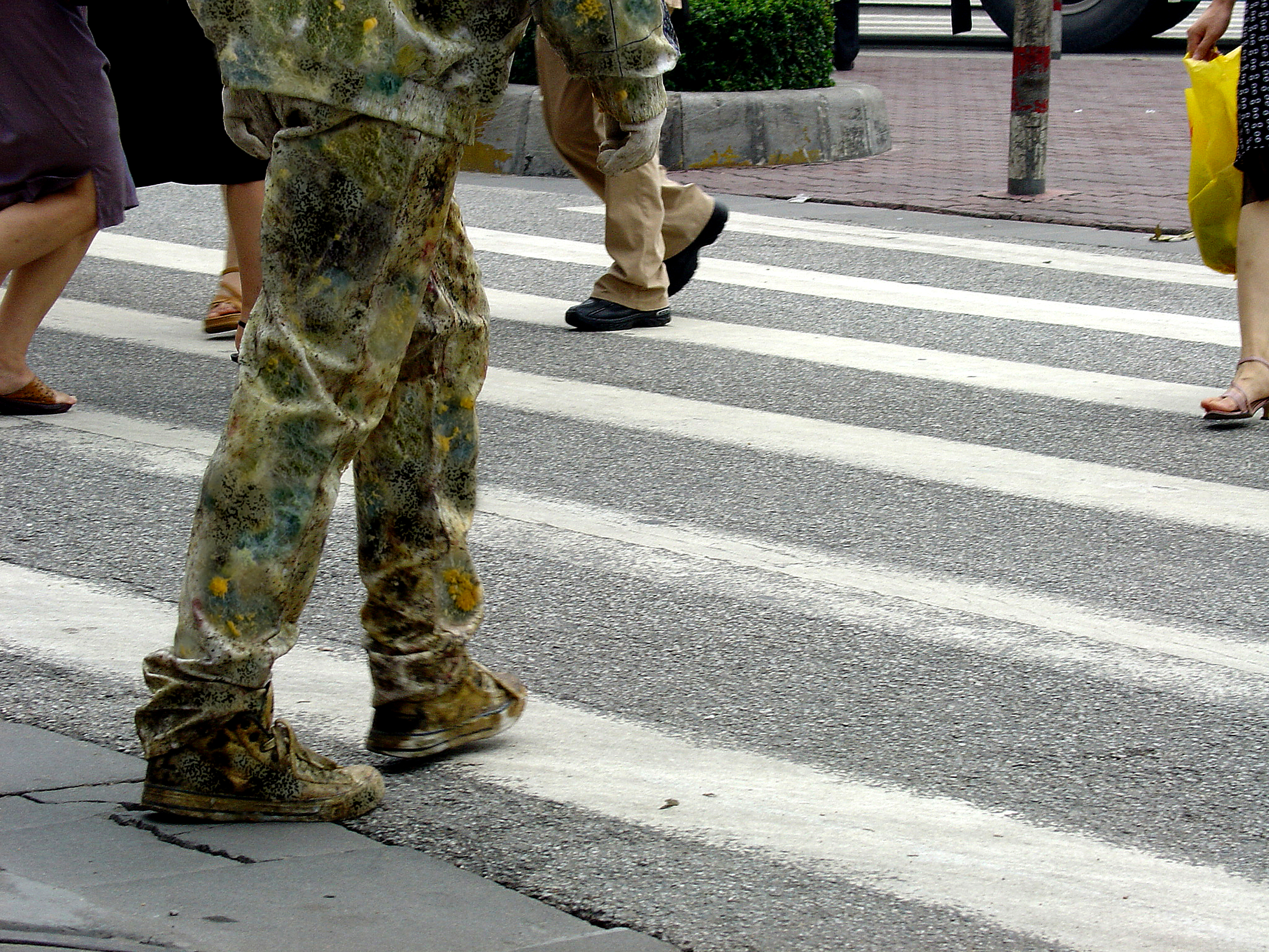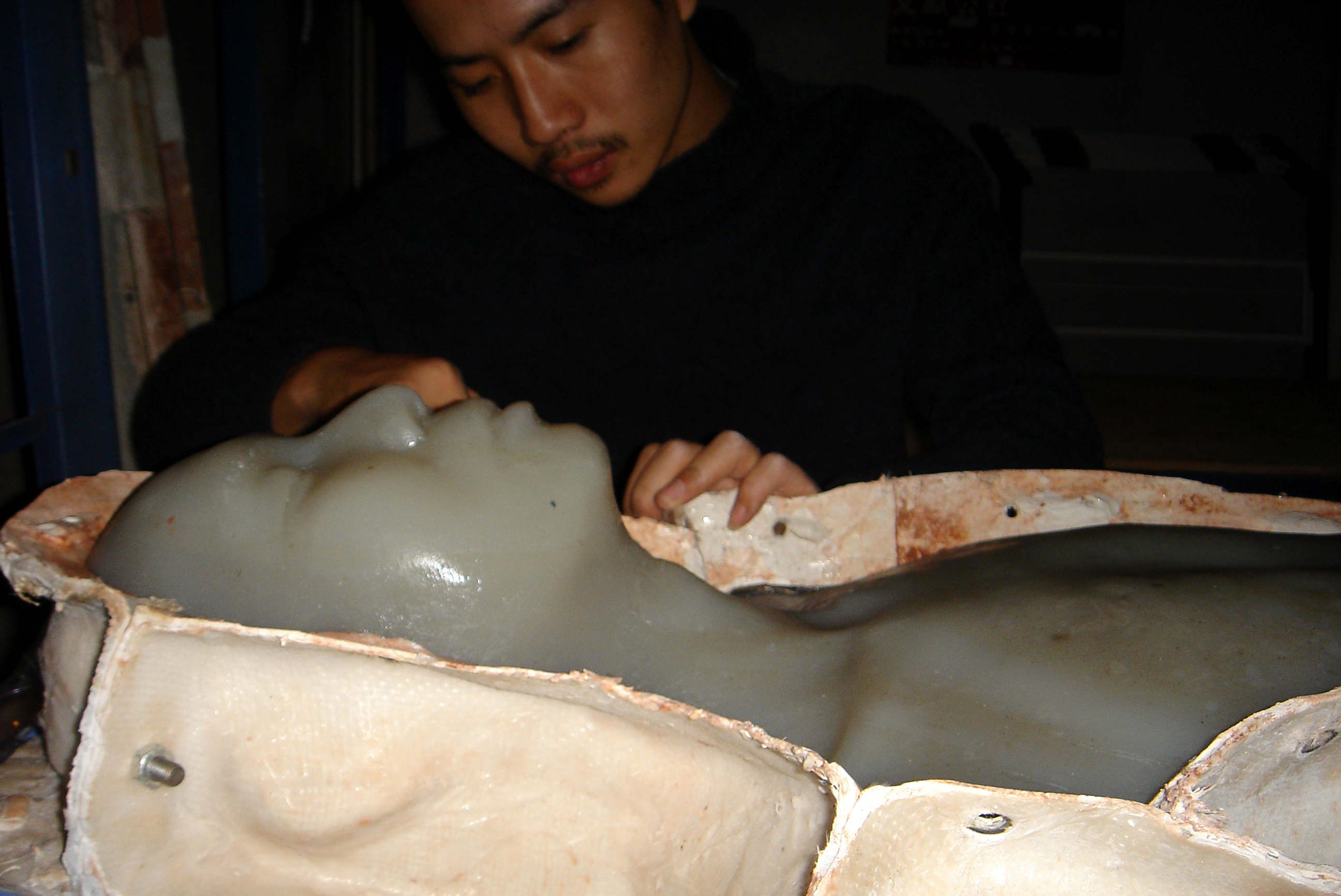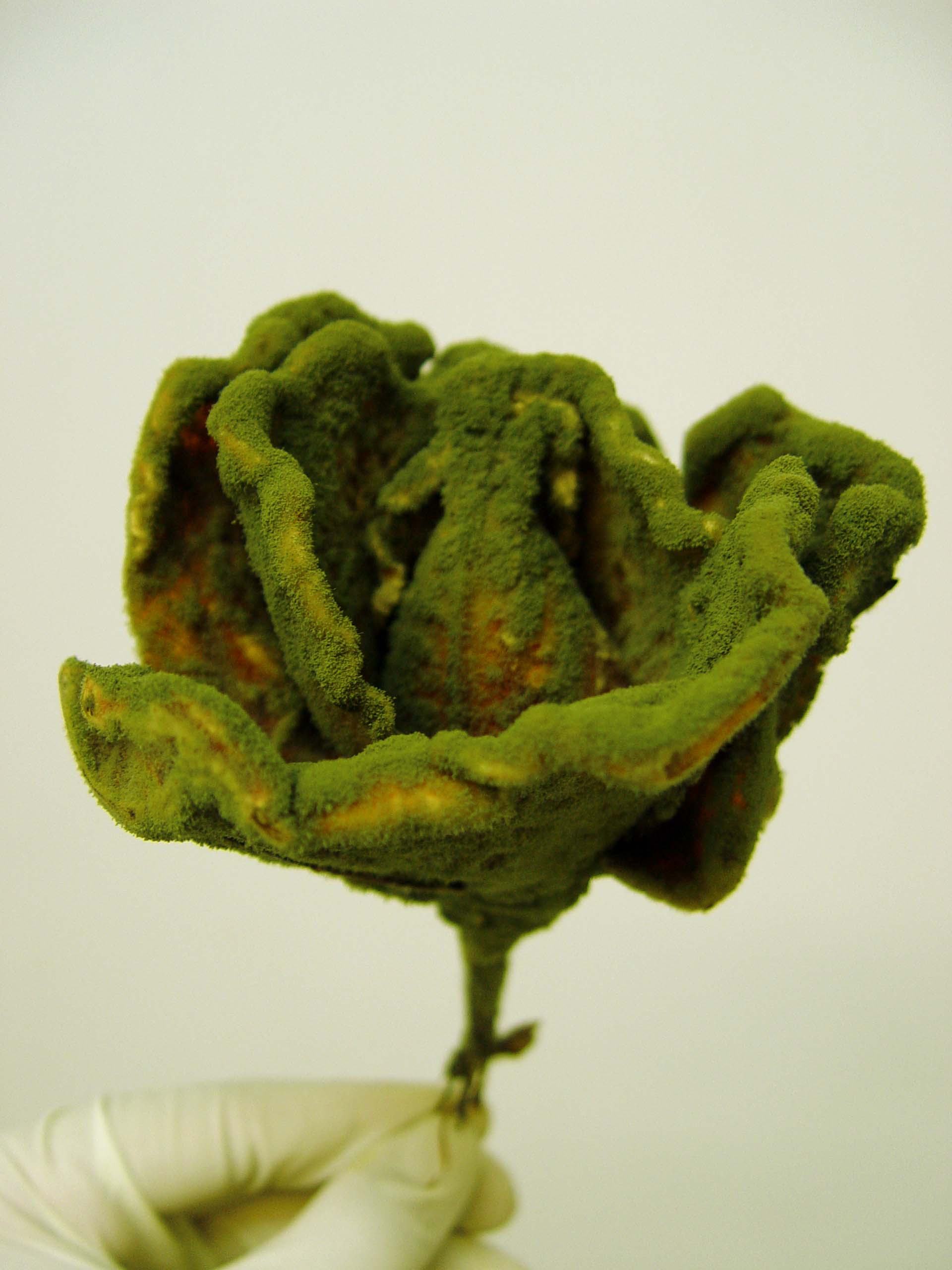 |
|
In 2008, Chen Youtong extracted the spores of Aspergillus Flavus in the air into a petri dish, diluted with sterile pure water, and brushed on the dried flowers, hoping to observe the effect of the colony fully grown. The color of Aspergillus Flavus is determined by the nutrients it obtains.
For example, rice is rich in starch, which makes Aspergillus flavus yellow. Chen Youtong used potato dextrose agar nutrient base, and the Aspergillus flavus colonies grew out of green. In a day and a half, the color of the mold attached to the dried flowers gradually changed from yellow-green to emerald green, dark green, and gray-green, completing their life cycle.
Aspergillus flavus and Aspergillus carbonarius, which are abundant in the air, are two kinds of molds often used by Chen Youtong. They have strong reproductive power and are better at grabbing nutrients than other molds in the air, and their visual effects are also more direct. "Their hyphae are strong and have a sense of lines. In contrast, Mucor's hyphae are soft and difficult to form.”
|
|
“The Orderly Space”
Time-lapse photography | Nutrient solution, microorganisms | 1′22″ | Shooting time: about one month | 2014
|
Since mankind jumped into the city of modernity, "human" has evolved from an ordinary or even insignificant factor in the whole world to the foundation and center of the whole world. As Heidegger pointed out: "Western history has now entered the process of completing what we call the modern era. This era is defined by the following fact: man becomes the scale and center of being." In such modernity, human beings rarely care about things other than "human" as the main body, except for the short-term reflections that are stimulated after the outbreaks of natural disasters.
Chen Youtong's exploration and thinking on microorganisms originated from the SARS outbreak in 2003. He uses "microorganisms" as his creative materials. Compared with traditional painting and sculpture materials, this is undoubtedly a great challenge. "Microorganisms" are active, aggressive, and efficient free traders and gamers, just as we see the coronavirus as a product of globalization penetrating every corner. It joins a grand process in a small way. When this power mechanism emerges, even, the culture collapses.
In the initial stage of creation, the artist was obsessed with the power and singularity of the microworld. He collected 20 antibiotic-producing strains from the national microbial strain bank for cultivation and creation. With the in-depth exploration of microorganisms and the observation of bacterial resistance and drug resistance performance, he discovered the mutual inhibition relationship when microorganisms grow, and they exist in the microworld by multiplying, fighting, death and rebirth.
With the gradual deepening of the relationship between the exploration of microorganisms, in 2008, there was a turning point in his creation. The observation and game of microorganisms become a symbiotic relationship. The state of life of microorganisms began to be highlighted in his works. The beauty of microorganisms, their multiplication, and fighting, form a subtle and strong antithetical relationship. In the exhibition, he combined the exhibition period to cultivate and present the life dynamics of microorganisms. Chen Youtong positioned himself at this stage as the constructor of the field and relationship.
In the nearly ten years from 2003 to 2017, Chen Youtong devoted almost all of his energy to the exploration of microorganisms and the exploration of related creations. He even set up professional laboratory equipment in his studio. During the creative process, the storage of his works became another huge challenge he needed to solve. He mentioned: "The microbiology teacher of the Chinese Academy of Sciences said that they only studied how to make the microorganisms live longer, and never thought about how to preserve the shape and color of the microorganisms for a long time." After years of experimentation, Chen Youtong used constant temperature air drying, hyphae hardening, and the method of plastic injection molding successfully preserved the microorganisms’ cells and colors (see the work "Circle").
”
However, compared to "preservation", Chen Youtong tends to "free-range" his creative medium in his creation, how microorganisms "create momentum" in the micro world, how to present the natural life process of microorganisms, and the concept of time produced by them in the process of change. It is the original intention and direction of his creation. Like a gamer, Chen Youtong constructs his artistic language through the relationship of layout, planting, fighting, symbiosis, and stimulation of the micro world. As he mentioned, “I think artists need to improve their scientific knowledge, to be able to effectively get along with reality, to maintain independent thinking, to have their own unique creative methods and language, and not just to make the works effective as an artist.” Just like Heidegger’s escape and opposition to anthropocentrism, Chen Youtong uses his identity as a gamer to explore the possibilities in the microworld and open up new freedoms beyond anthropocentrism. This also aptly shows his position on the relationship between human beings, nature, and microorganisms.
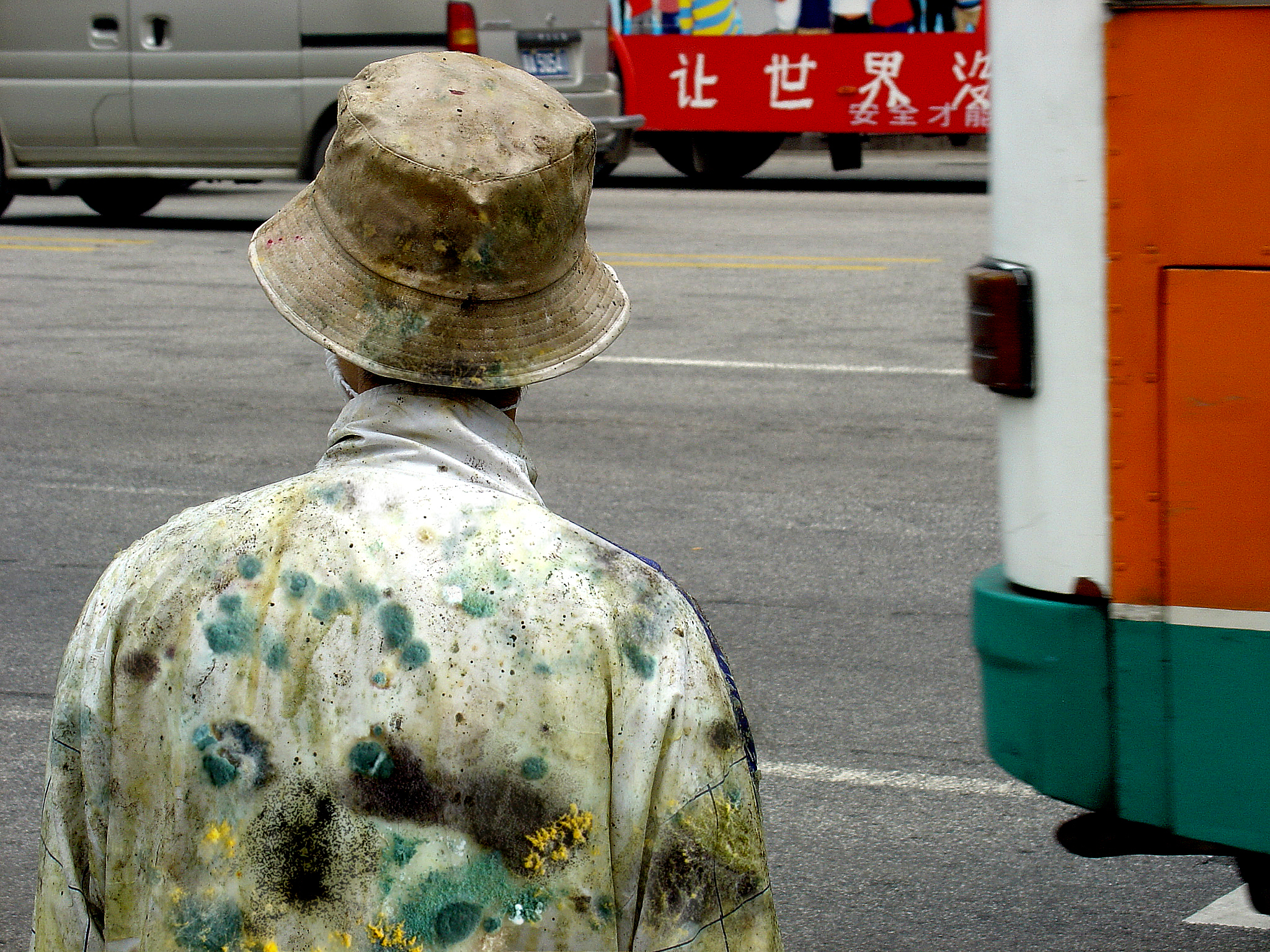 |
|
“Reproduction”
Performance Art| Streets of Guangzhou | 2004
Chen Youtong wore a set of clothes soaked in potato dextrose culture medium and walked on the streets of Guangzhou for more than an hour, allowing microorganisms in the air to adhere to the clothes, and then returned to the studio to seal the clothes and cultivate them so that the microorganisms could fully grow. Four days later, Chen Youtong returned to the street wearing this set of clothes.
|
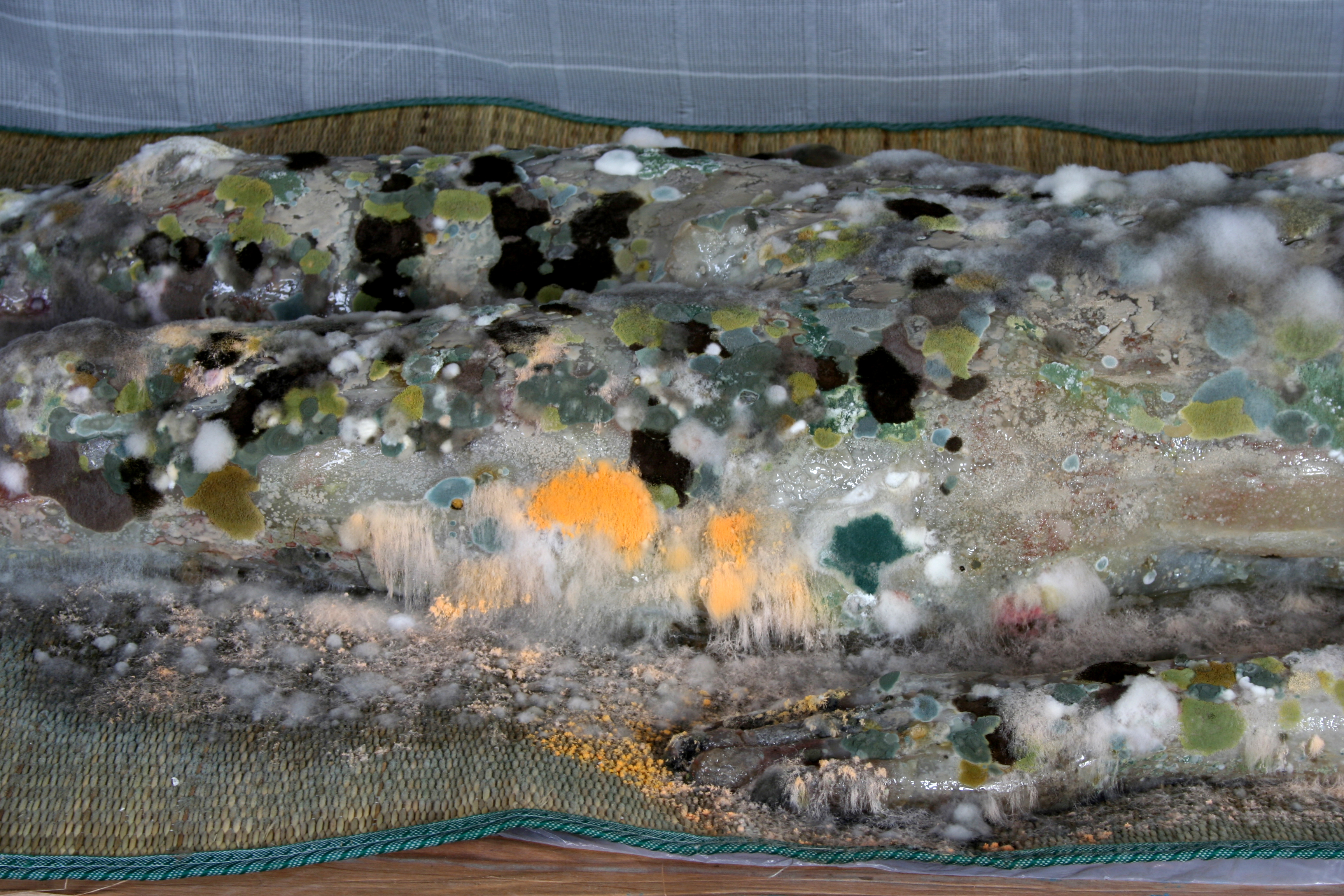 |
|
“Reproduction”
Living site-specific art | Potato agar nutrient base, microorganisms in the air | November 17-28, 2005
The artist used nutrient bases to mold a man and a woman and then placed the two nutrient bases on the bed. During the ten days, the nutrient-filled human body nourished various microorganisms in the air, and the shape continued to change. Due to the different life cycles of different microorganisms, the dead bodies of microorganisms were also providing nutrients for other microorganisms until all nutrients were exhausted.
|
With the gradual deepening of the artist's knowledge of microorganisms and the upgrading of laboratory equipment, he began to isolate microorganisms in 2007, isolating and controlling the messy microorganisms in reality. His creation also began to shift to the form management and order regulation of life forms, the visual form of creation became more orderly as a result. Since then, the artist has begun to collect, purchase, and preserve microorganisms in large quantities.
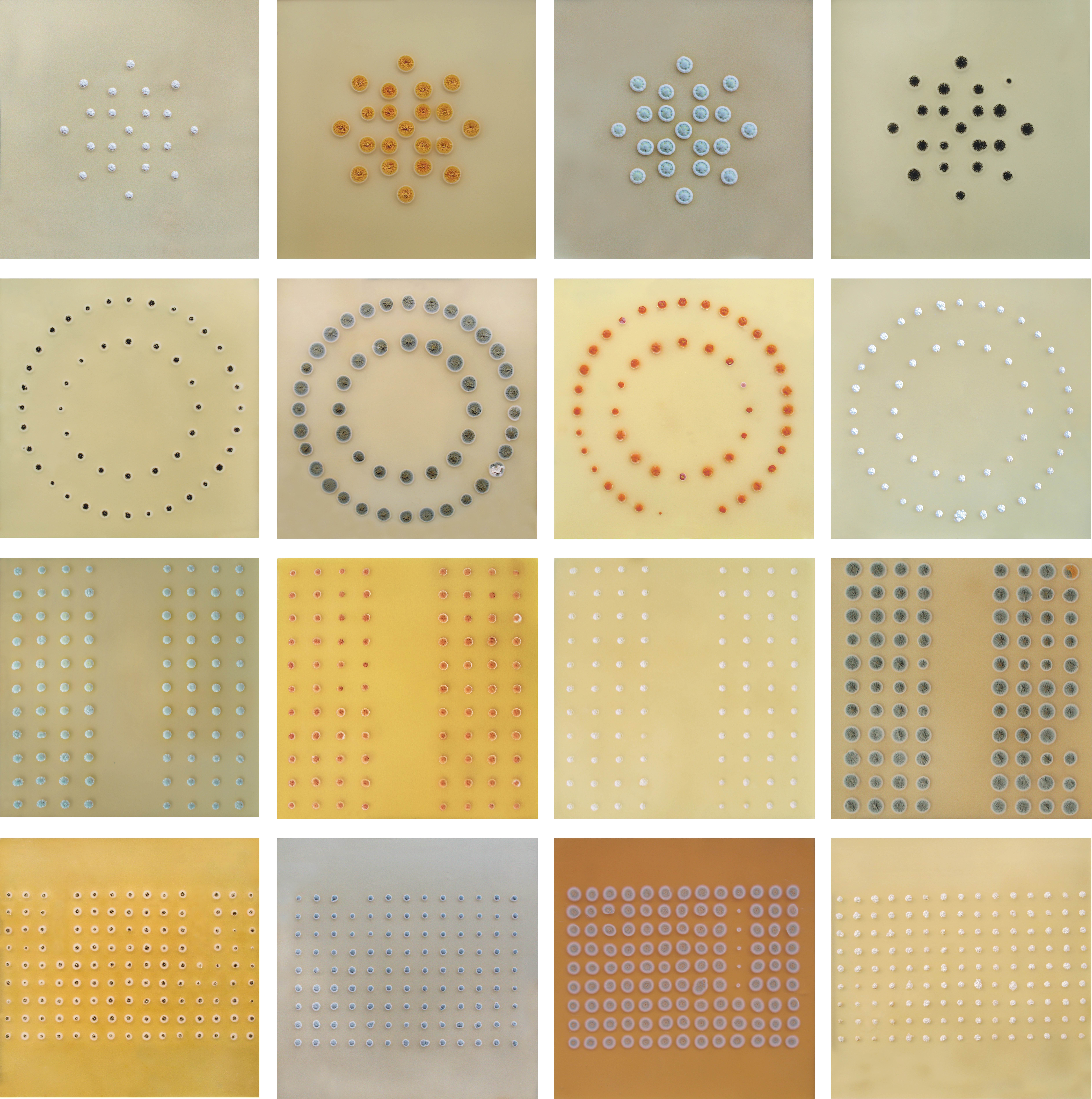 |
|
“Isolation” (Detailed view)
Site-specific live art | Nutrient solution, microorganism | 60 x 60 cm | September 28 to October 18, 2008
|
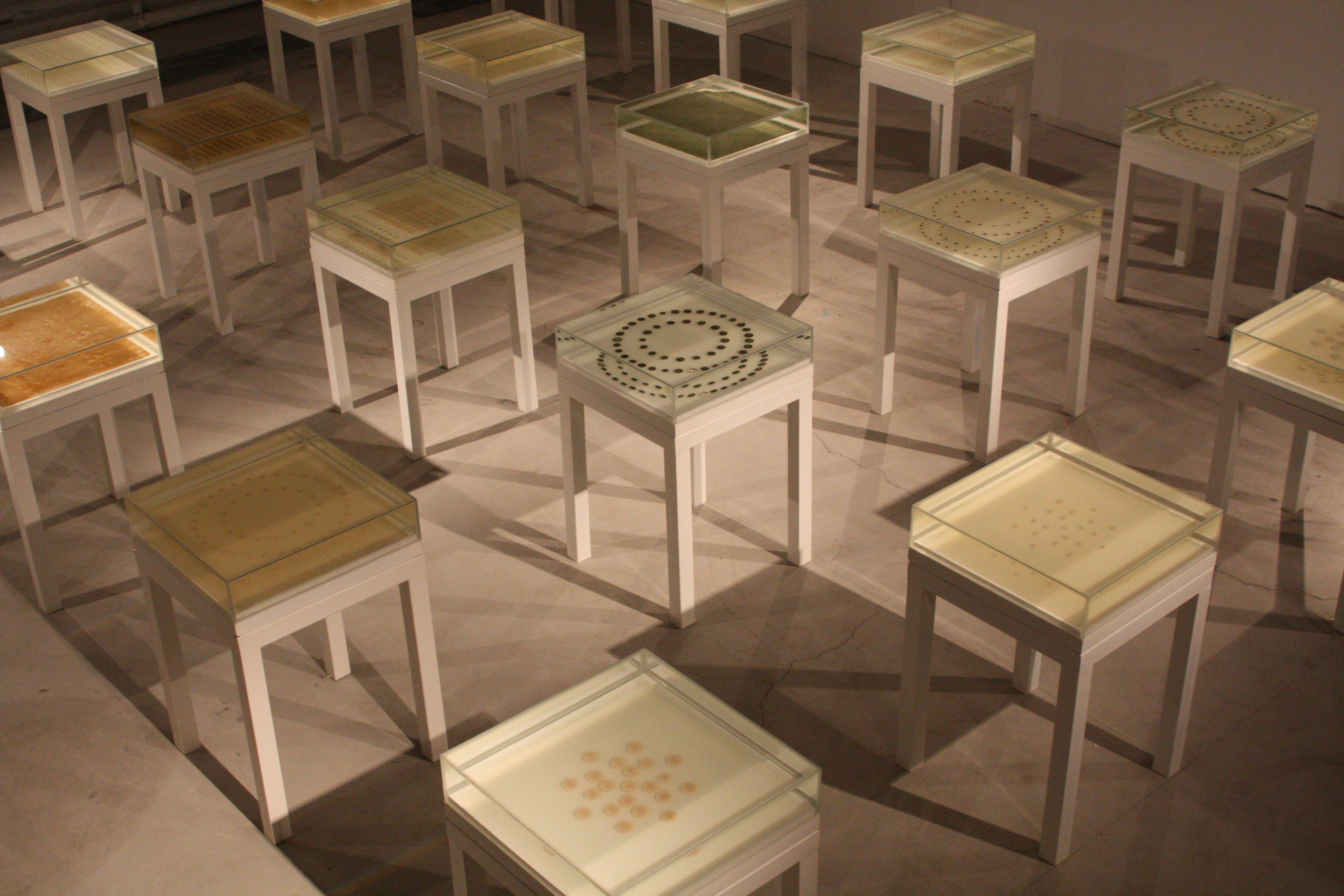 |
|
“Isolation” (Detailed view)
Site-specific live art | Nutrient solution, microorganism | 60 x 60 cm | September 28 to October 18, 2008
|
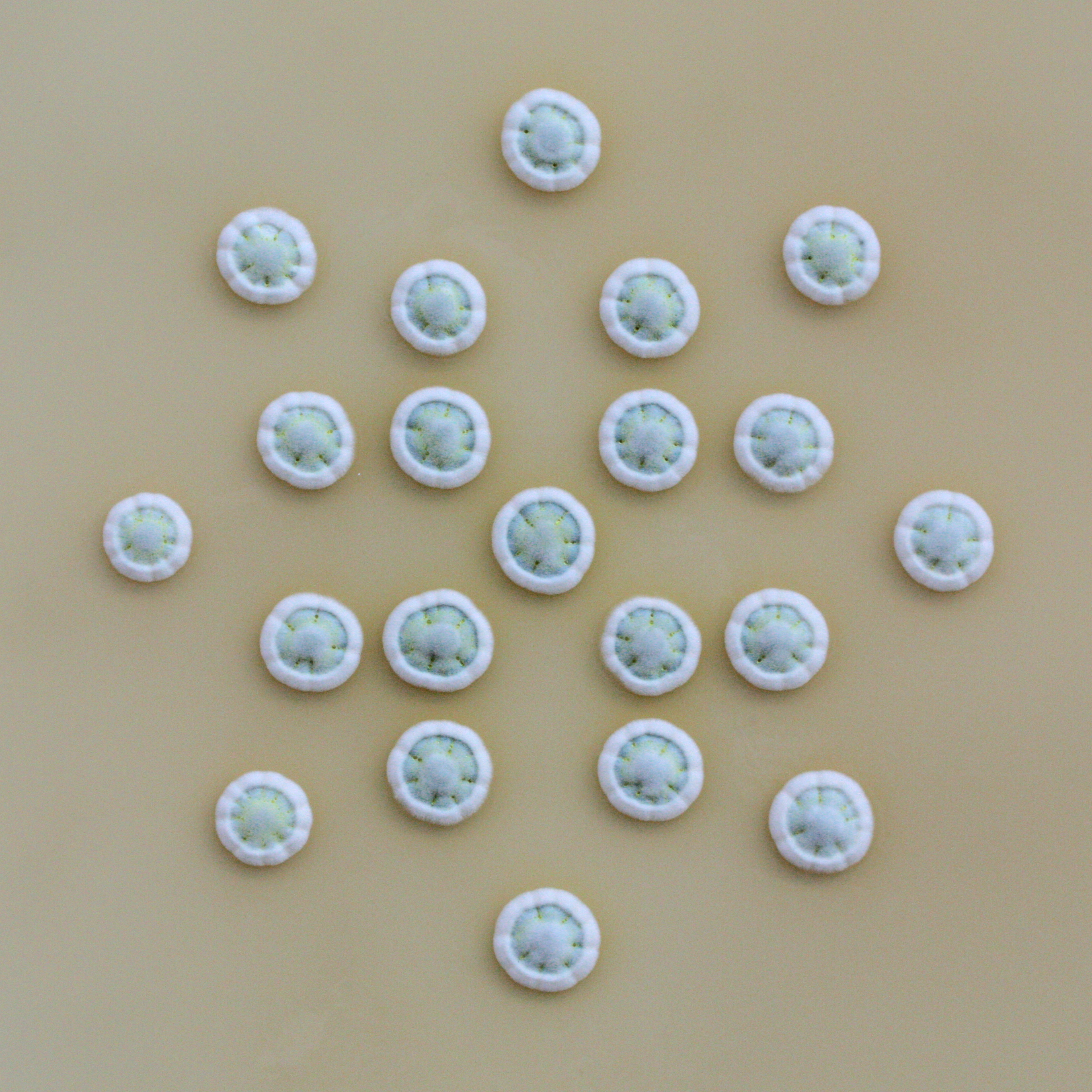 |
|
“Isolation” (Detailed view)
Site-specific live art | Nutrient solution, microorganism | 60 x 60 cm | September 28 to October 18, 2008
|
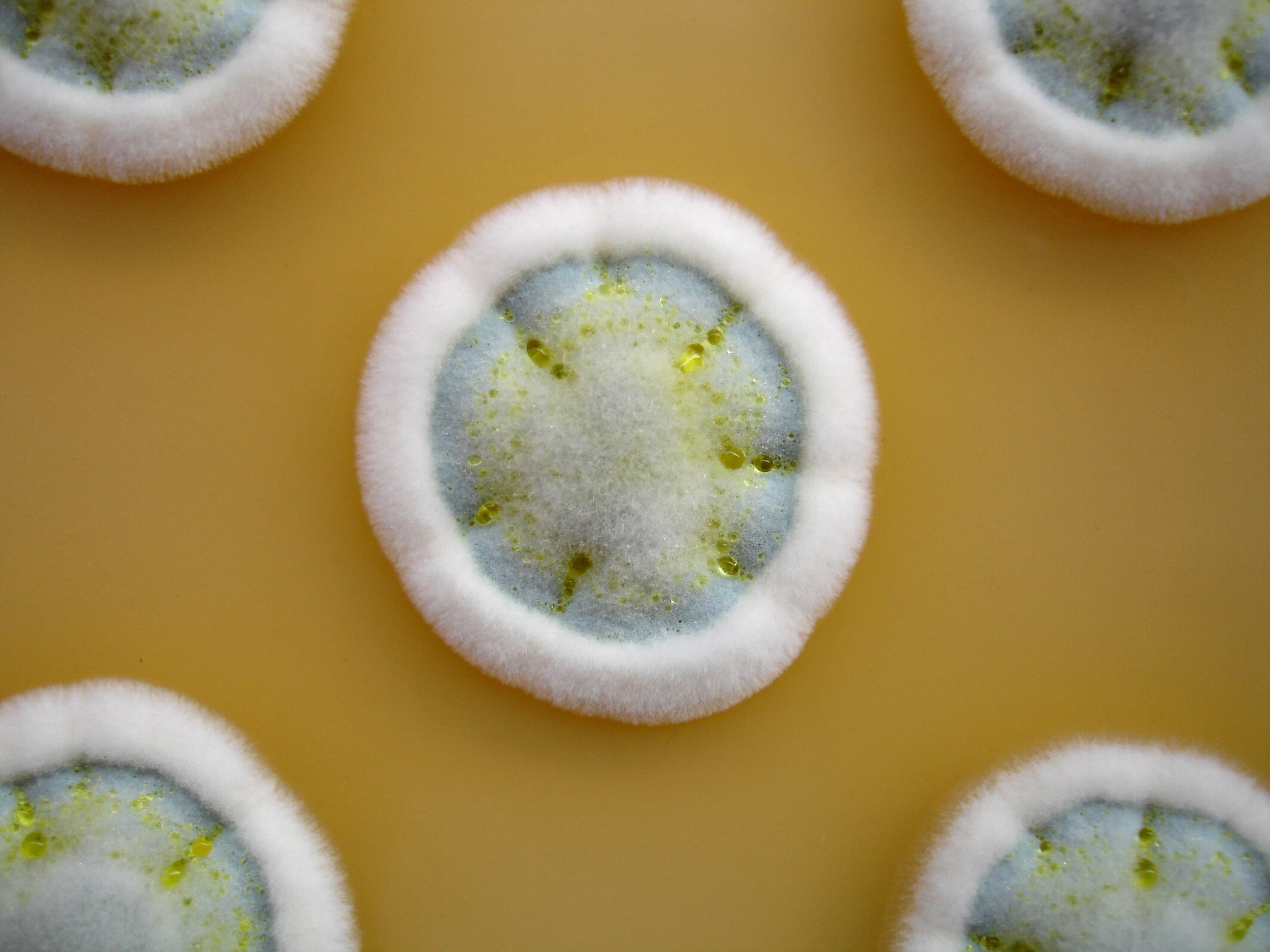 |
|
“Isolation” (Detailed view)
Site-specific live art | Nutrient solution, microorganism | 60 x 60 cm | September 28 to October 18, 2008
|
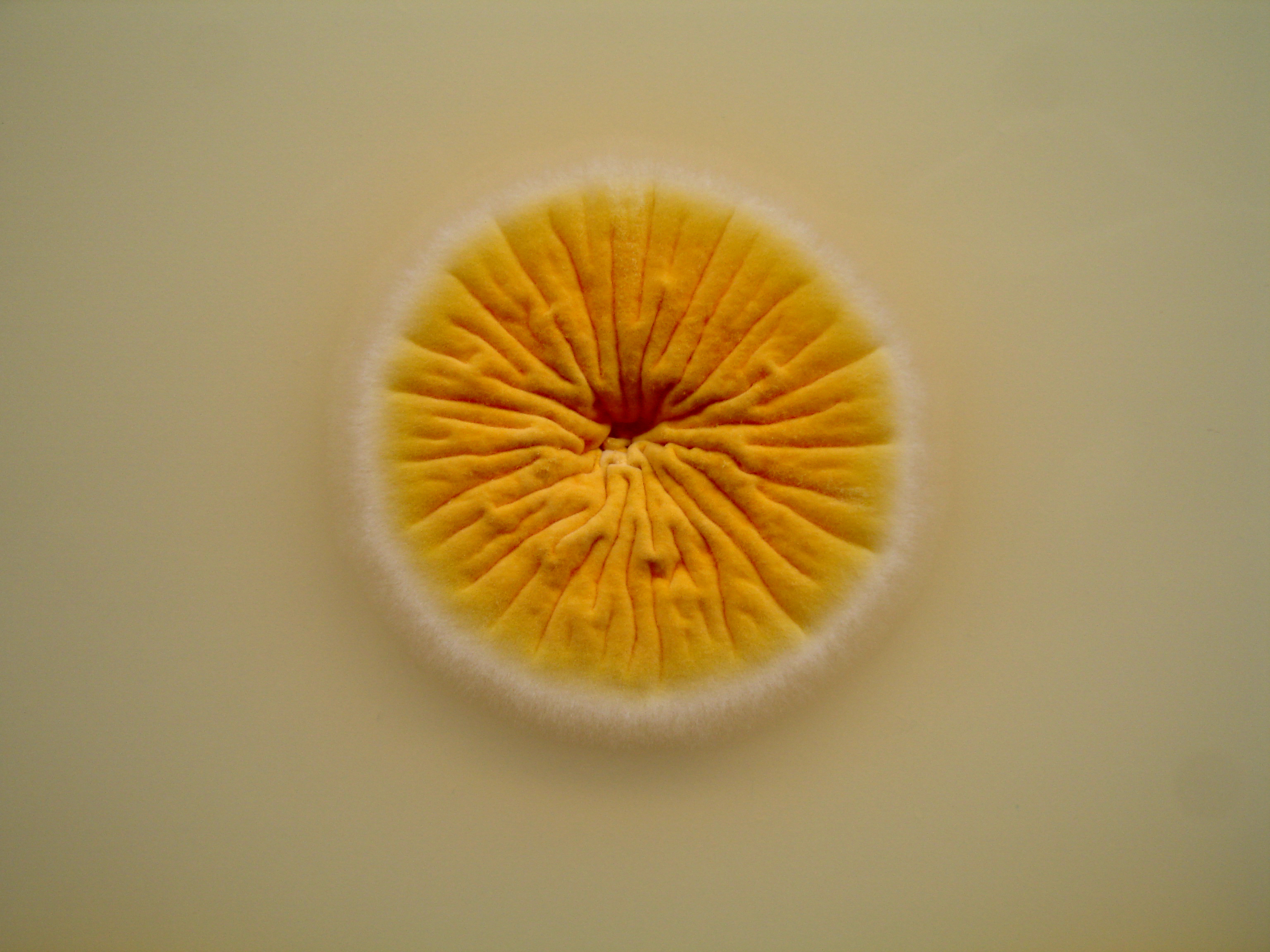 |
|
“Isolation” (Detailed view)
Site-specific live art | Nutrient solution, microorganism | 60 x 60 cm | September 28 to October 18, 2008
|
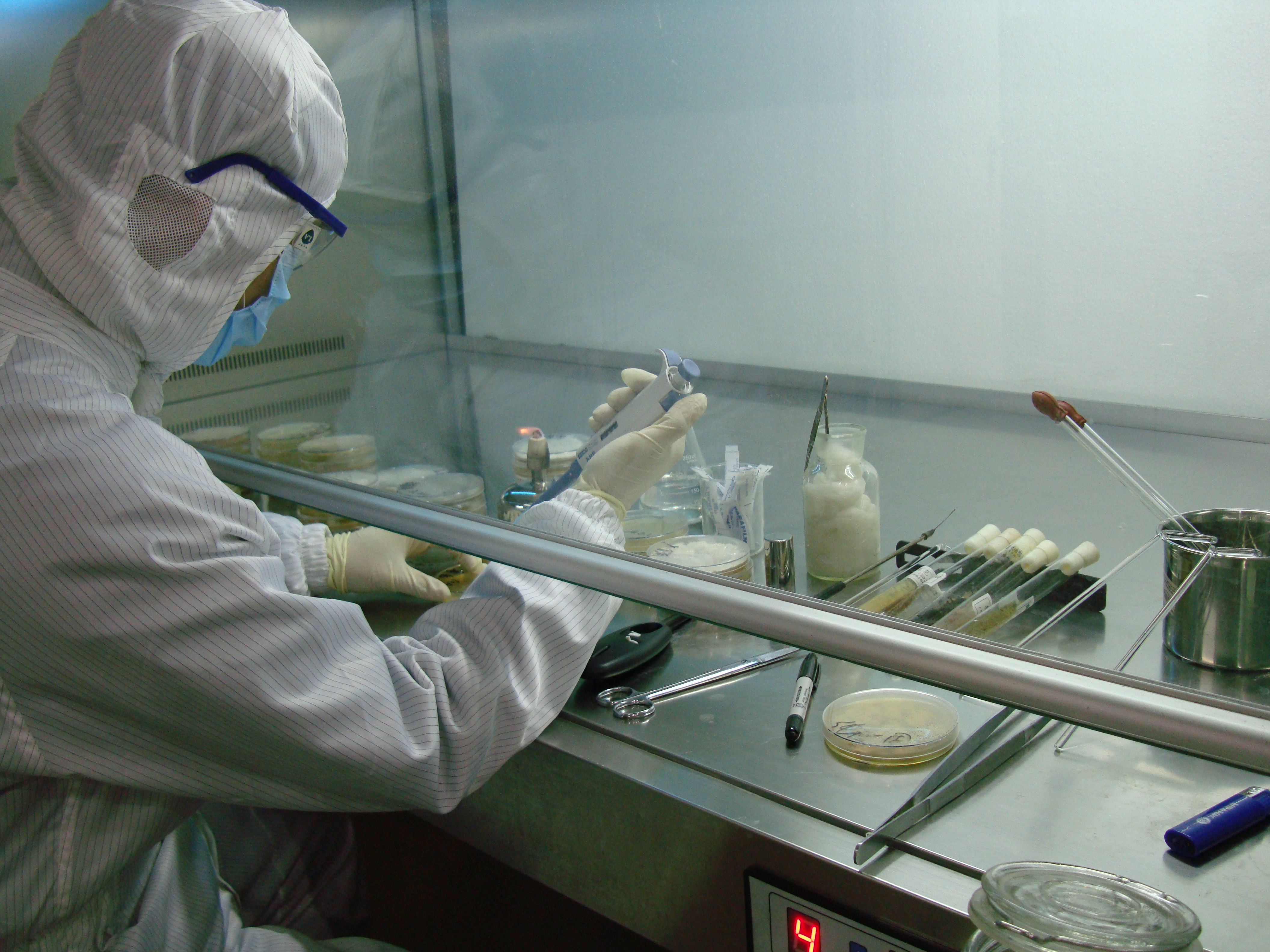 |
|
Chen Youtong is mixing the nutrient solution in his Beijing studio. Although there are a large number of microorganisms in the human living environment, however as long as the immunity is normal, people will not get sick. At the same time, the human body also needs the interaction of various microorganisms to maintain balance, so in general, no special protective measures are required. Compared with being affected by microorganisms, Chen Youtong is more worried about the influence of the body on the microorganisms in the works. The nutrient base used by Chen Youtong is much larger than the size used in general laboratories, and the failure rate in the process of transplanting spores will also increase. All operations in the experiment must be completed at once, the fewer the actions, the less pollution. When creating, the artist needs to finish it in one go. If the work is large, it needs to be prepared for an aseptic operation in the morning, he cannot eat and work until late at night.
|
 |
|
Chen Youtong is transferring nutrient bases for microorganisms in his studio. He obtained the microorganisms from the China General Microbiological Culture Collection Center in Beijing and related institutions in Guangdong Province. Chen Youtong would also extract microorganisms in his living space and body for creation.
|
In the creation of "The Orderly Space" series, the artist juxtaposes different types of microorganisms. Different microorganisms compete for nutrients and inhibit each other during the growth process, forming various patterns in this process.
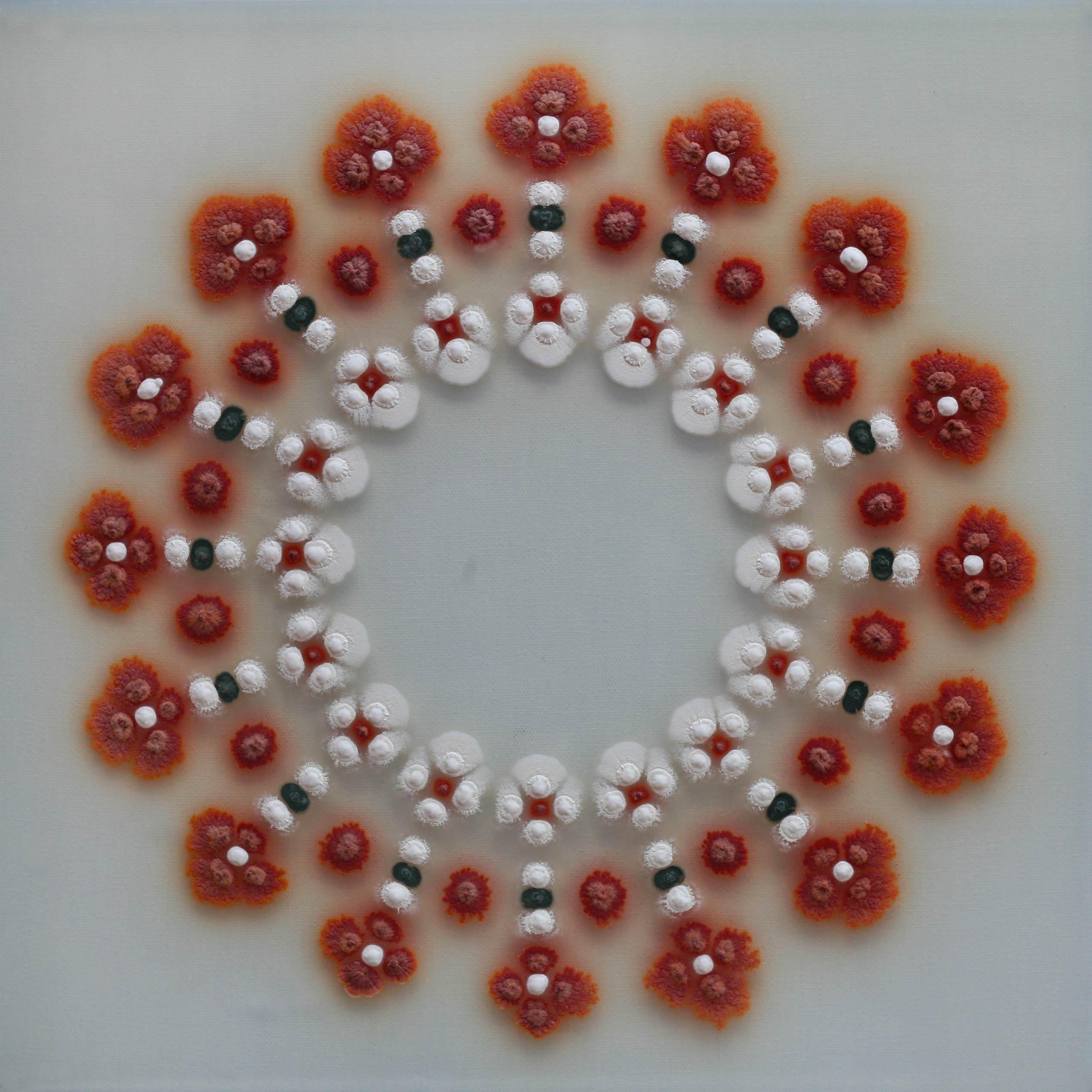 |
|
“The Orderly Space”
Site-specific live art | Nutrient solution, microorganism | 60 x 60 x 2 cm | 2013
|
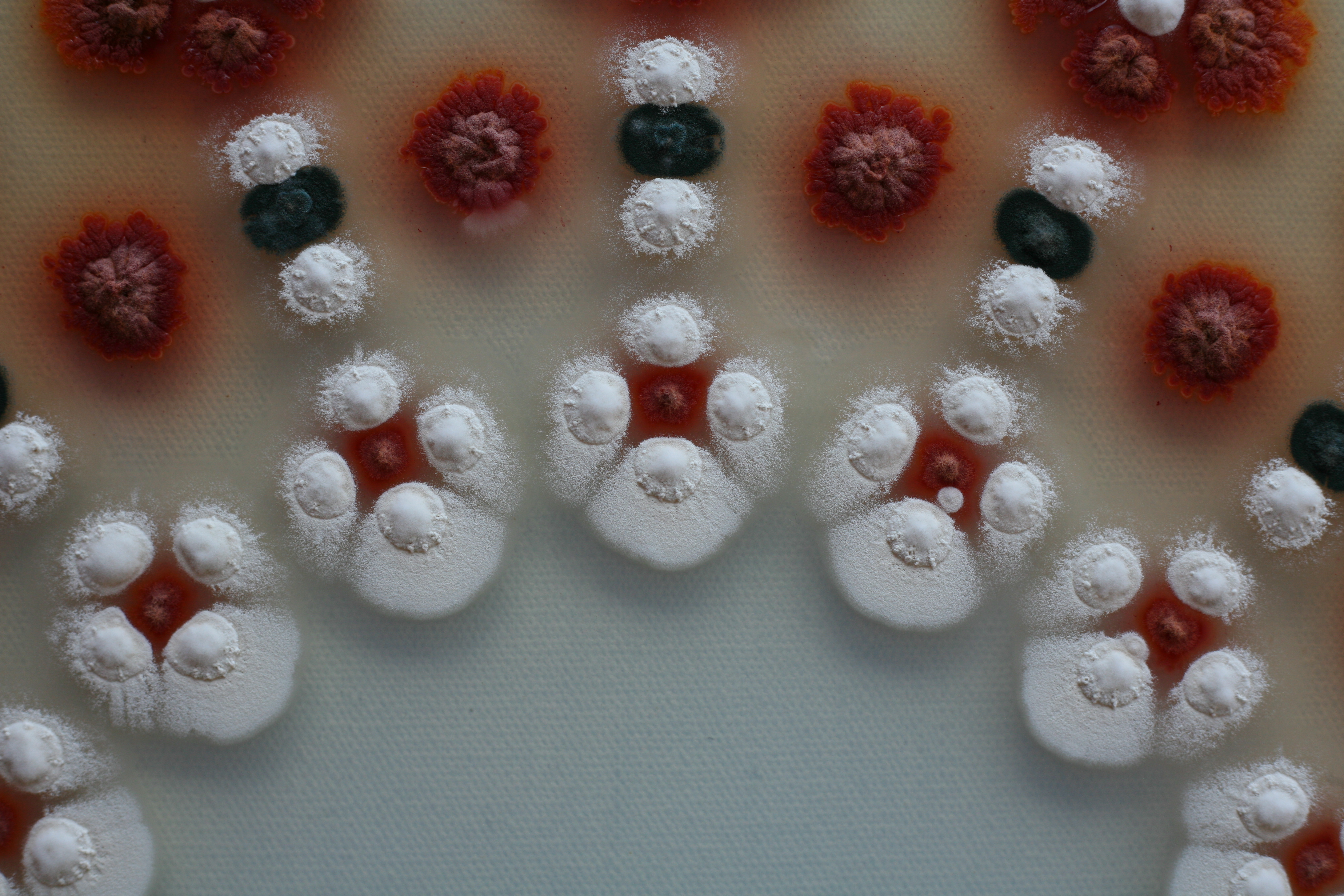 |
|
“The Orderly Space” (Detailed view)
Site-specific live art | Nutrient solution, microorganism | 60 x 60 x 2 cm | 2013
|
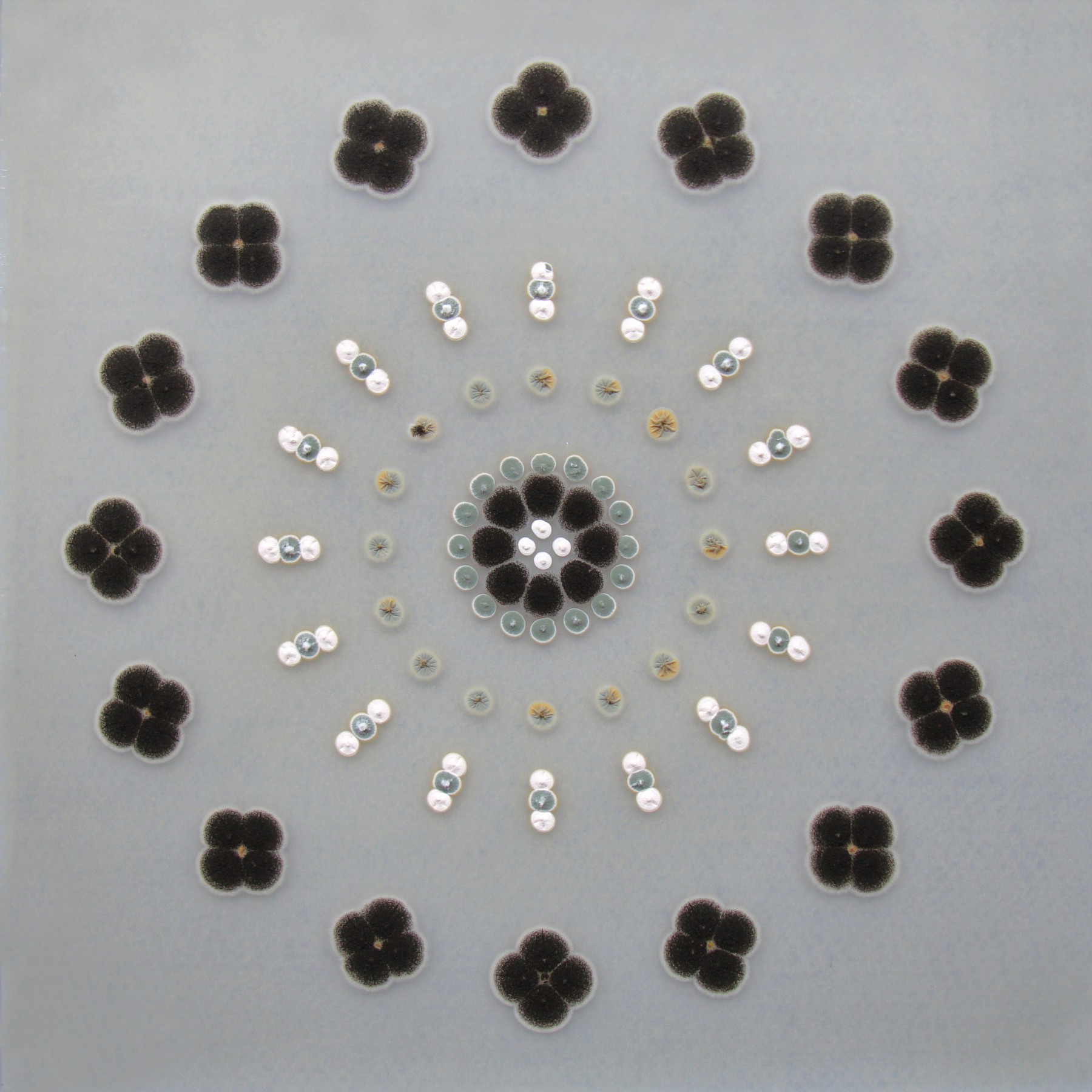 |
|
“The Orderly Space”
Site-specific live art | Nutrient solution, microorganism | 60 x 60 x 2 cm | 2010
|
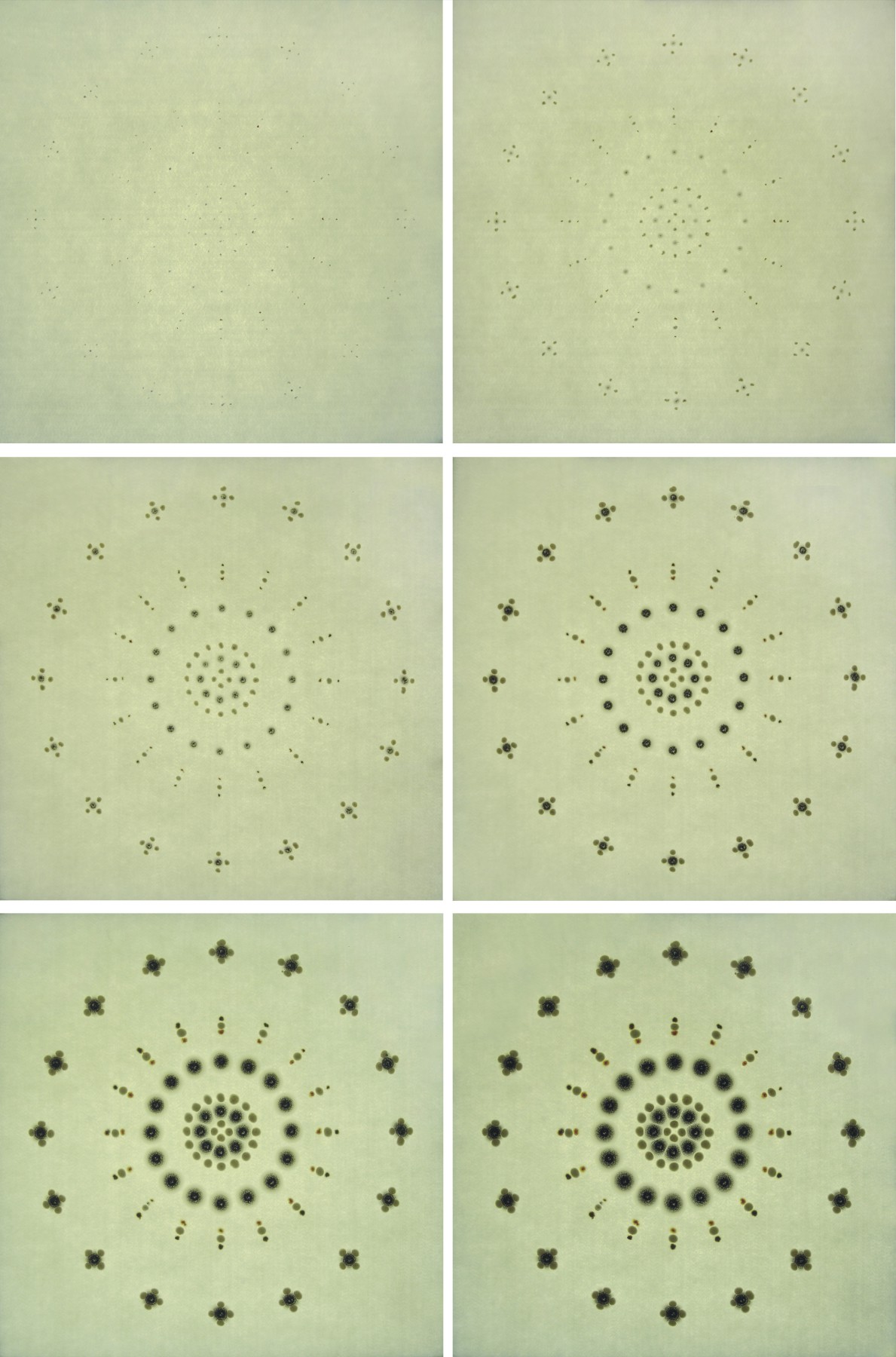 |
|
“The Orderly Space” (The growth process)
Site-specific live art | Nutrient solution, microorganism | 60 x 60 x 2 cm | 2010
|
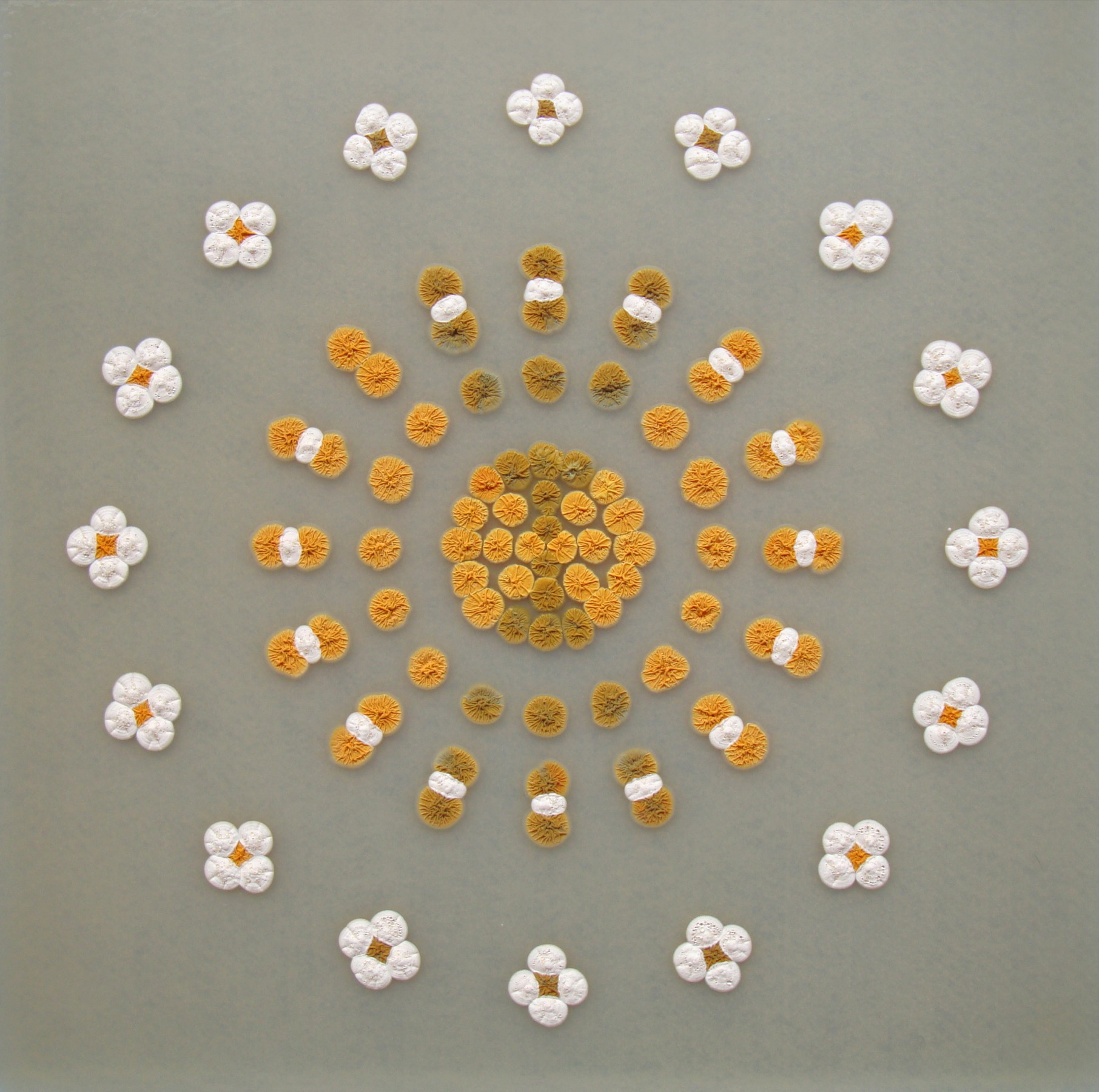 |
|
“The Orderly Space” (The growth process)
Site-specific live art | Nutrient solution, microorganism | 60 x 60 x 2 cm | 2010
|
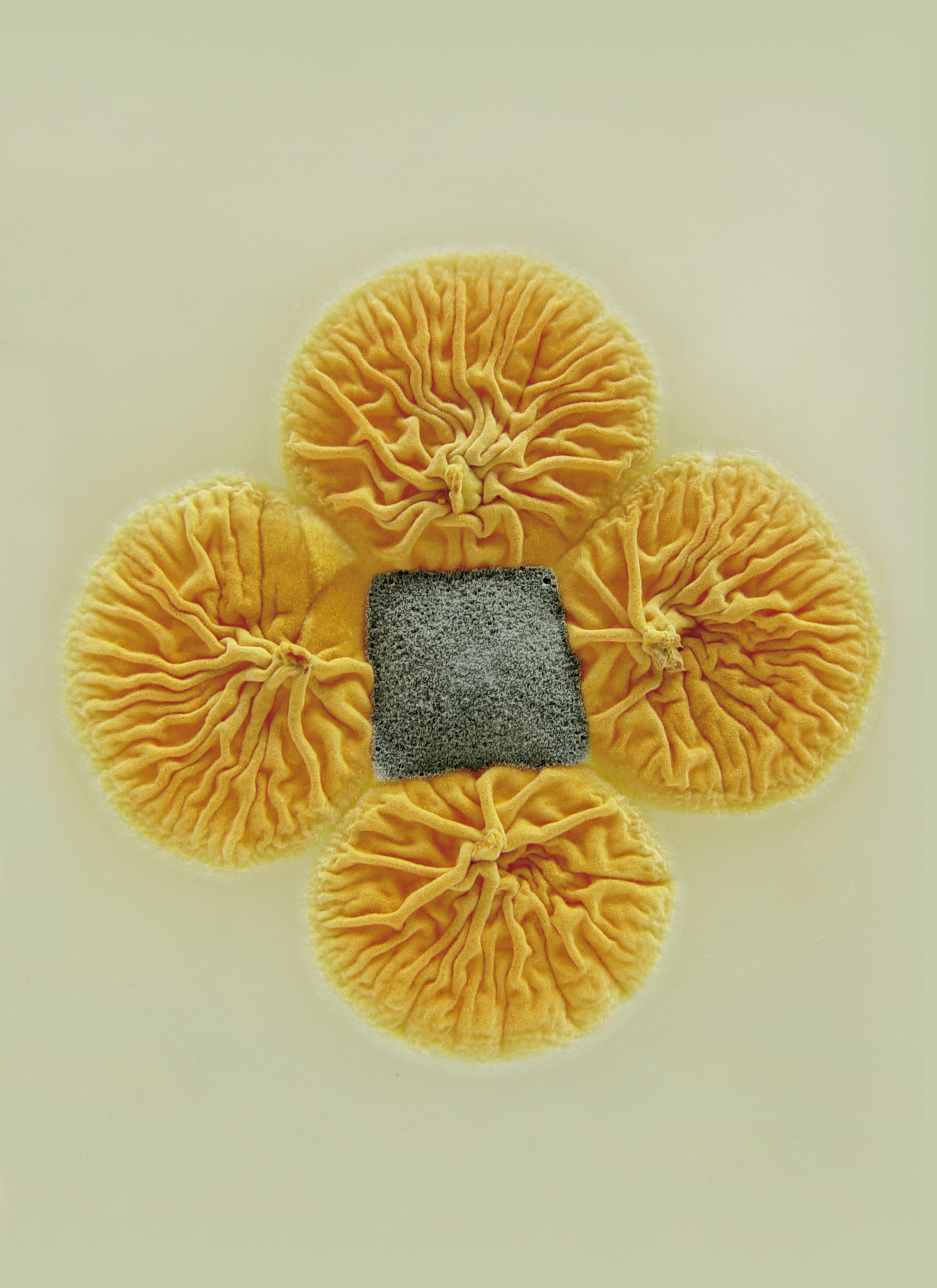 |
|
“The Orderly Space” (Detailed view)
Site-specific live art | Nutrient solution, microorganism | 60 x 60 x 2 cm | Since 2008
This is a pattern formed by four colonies of Aspergillus orange, enveloping a colony of Penicillium. Penicillium becomes "weak" after encountering Aspergillus orange, its natural growth tends to grow into a circle is suppressed, and it grows into a square. In order to make this work "survive", the artist needs to switch nutrition twice a year and store it in a refrigerator at 4°C. After three years, the Aspergillus orange colonies that were originally full of wrinkles became much smoother.
|
|
“The Orderly Space”
Time-lapse photography | Nutrient solution, microorganisms | 1′ | Shooting time: about one week | 2012
|
|
“The Orderly Space”
Time-lapse photography | Nutrient solution, microorganisms | 45′’ | Shooting time: about one week | 2012
|
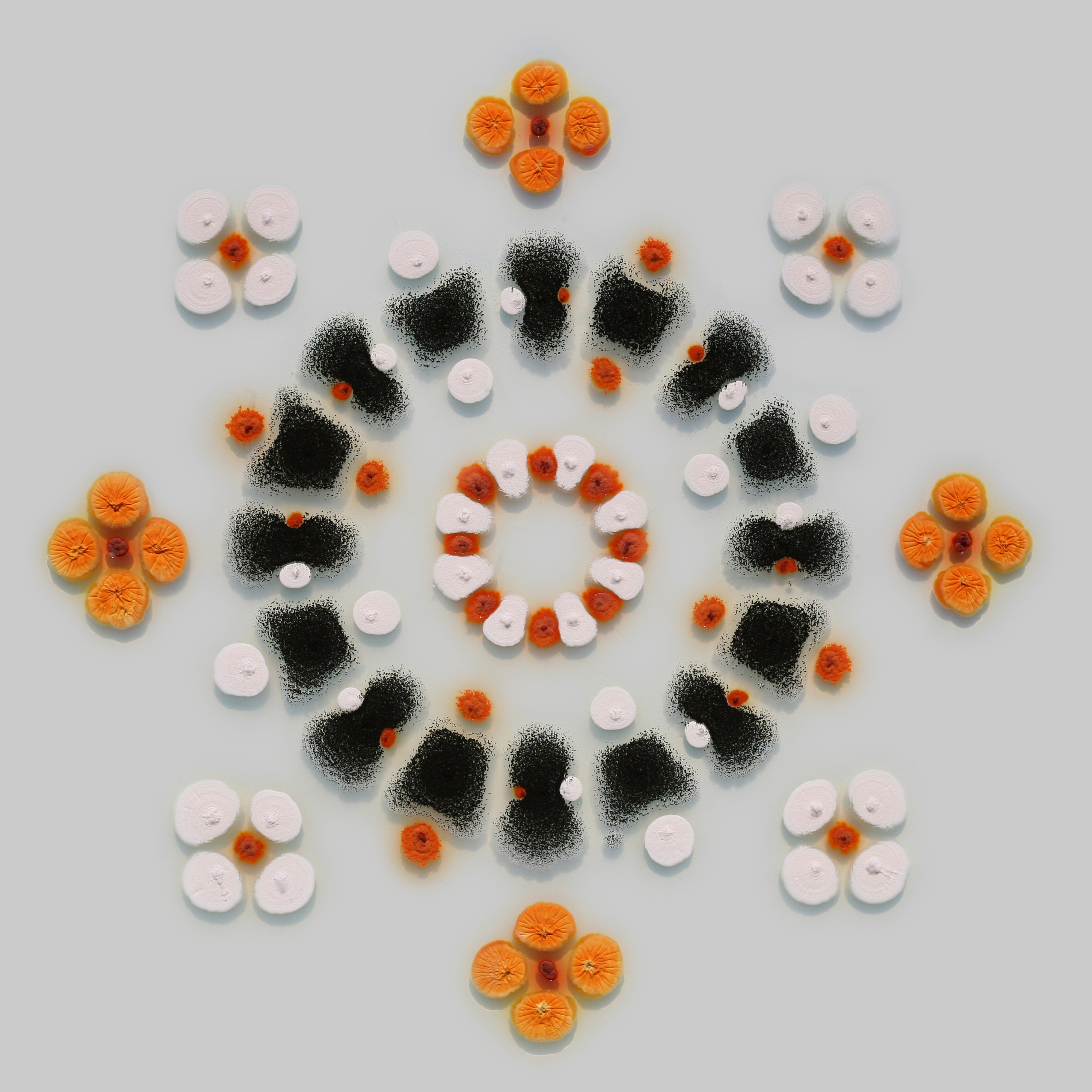 |
|
“The Orderly Space”
Site-specific live art | Nutrient solution, microorganism | 60 x 60 x 2 cm | 2013
|
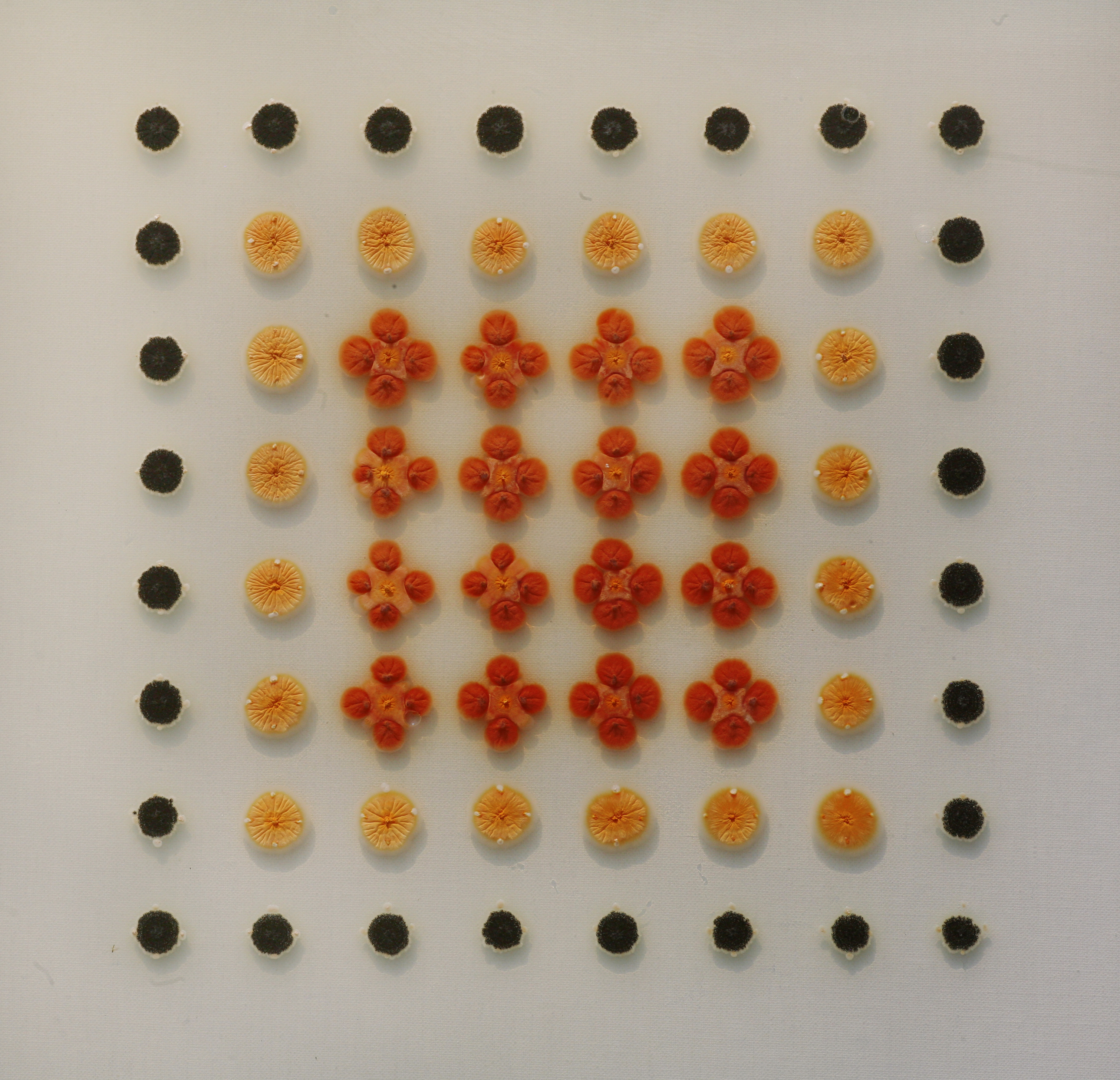 |
|
“The Orderly Space”
Site-specific live art | Nutrient solution, microorganism | 60 x 60 x 2 cm | 2013
|
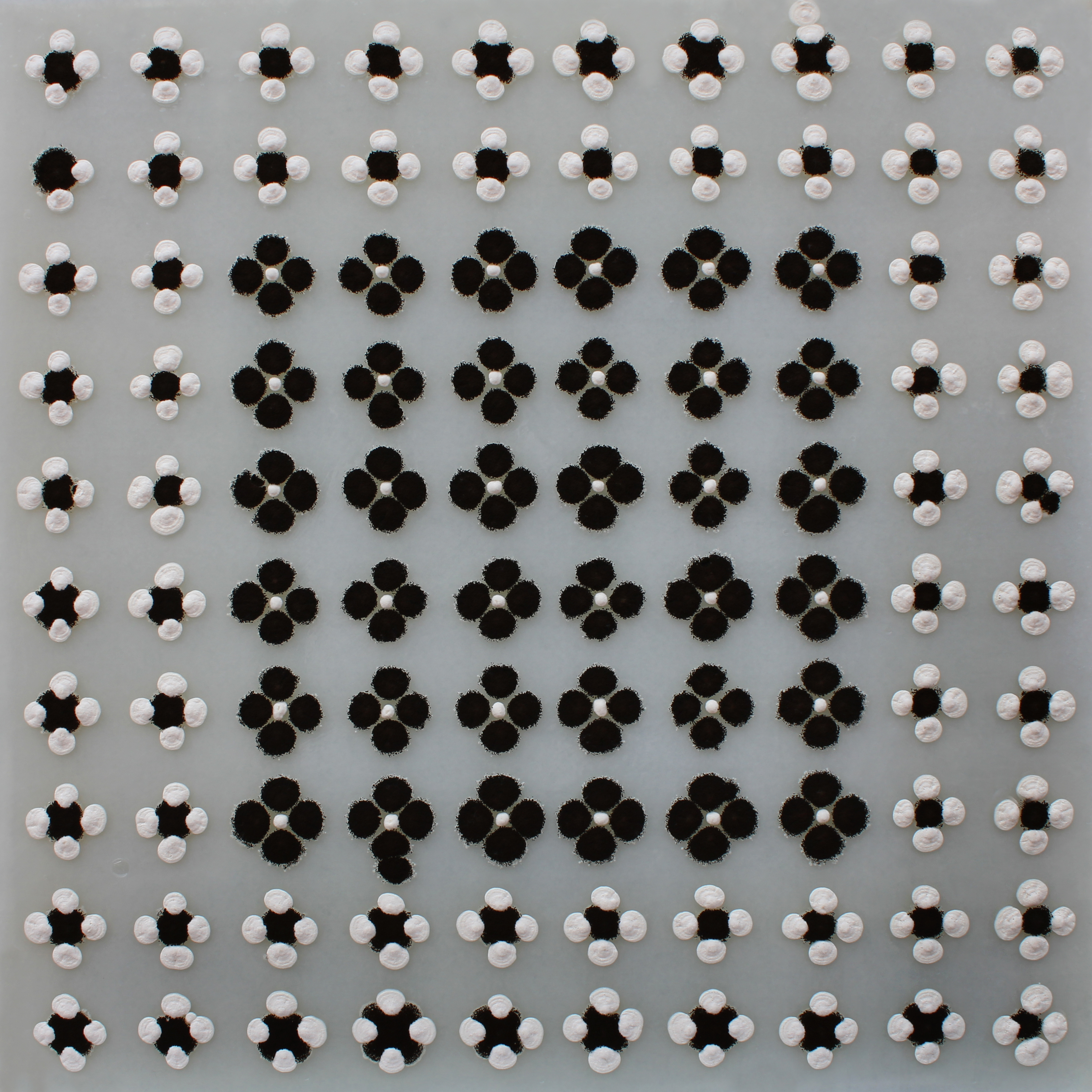 |
|
“The Orderly Space”
Site-specific live art | Nutrient solution, microorganism | 60 x 60 x 2 cm | 2013
|
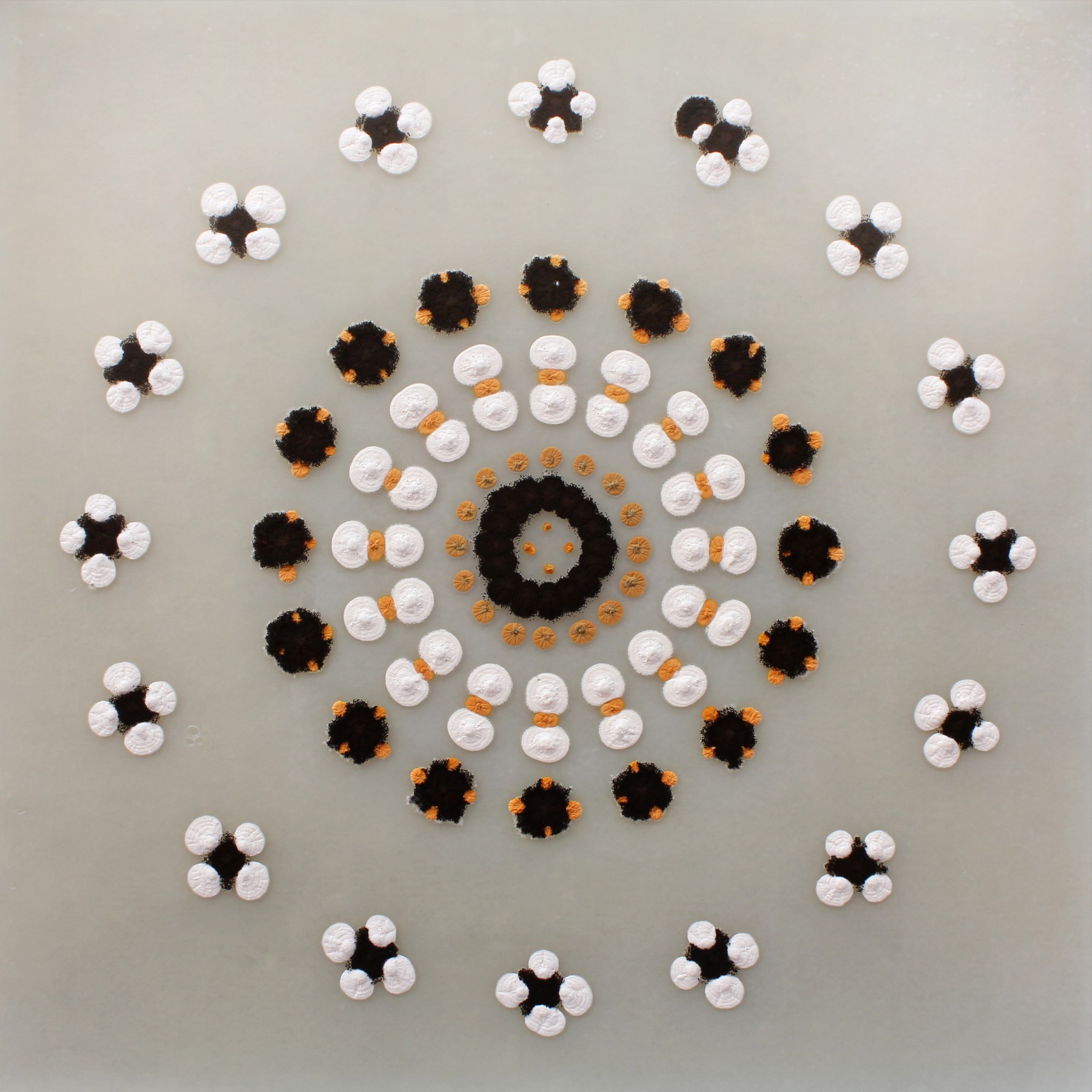 |
|
“The Orderly Space”
Site-specific live art | Nutrient solution, microorganism | 60 x 60 x 2 cm | 2013
|
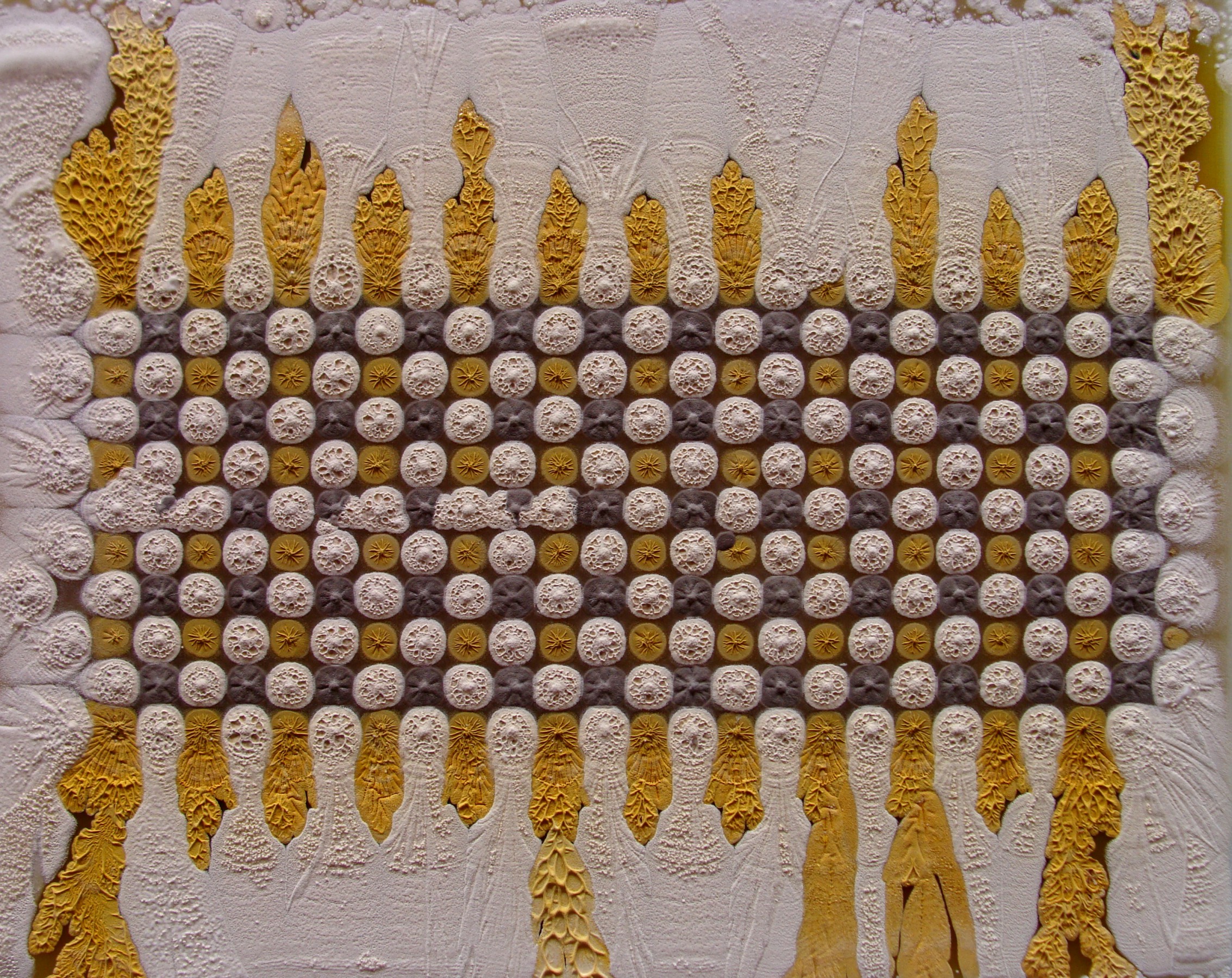 |
|
“The Orderly Space”
Site-specific live art | Nutrient solution, microorganism | 60 x 60 x 2 cm | 2008 |
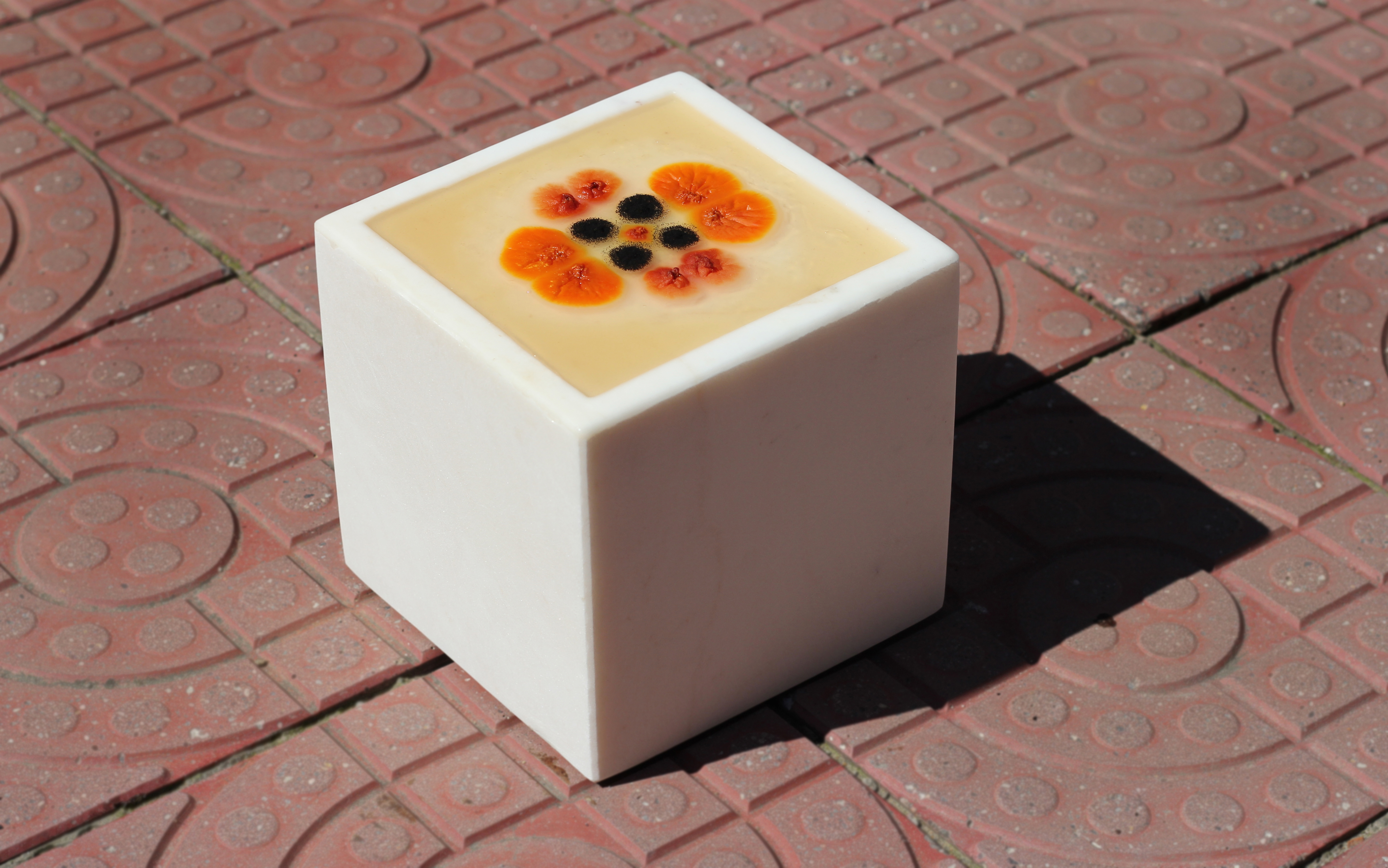 |
|
“Order/Life”
Site-specific live art | Nutrient solution, microorganism, white marble | 15 x 15 x 15 cm | 2014
|
The seemingly stable and orderly spaces are constantly changing and conflicting; units with similar appearances actually contain many differences and often appear in "unexpected" shapes, showing the contingency of microbiological growth and the multi-faceted self-organization of life.
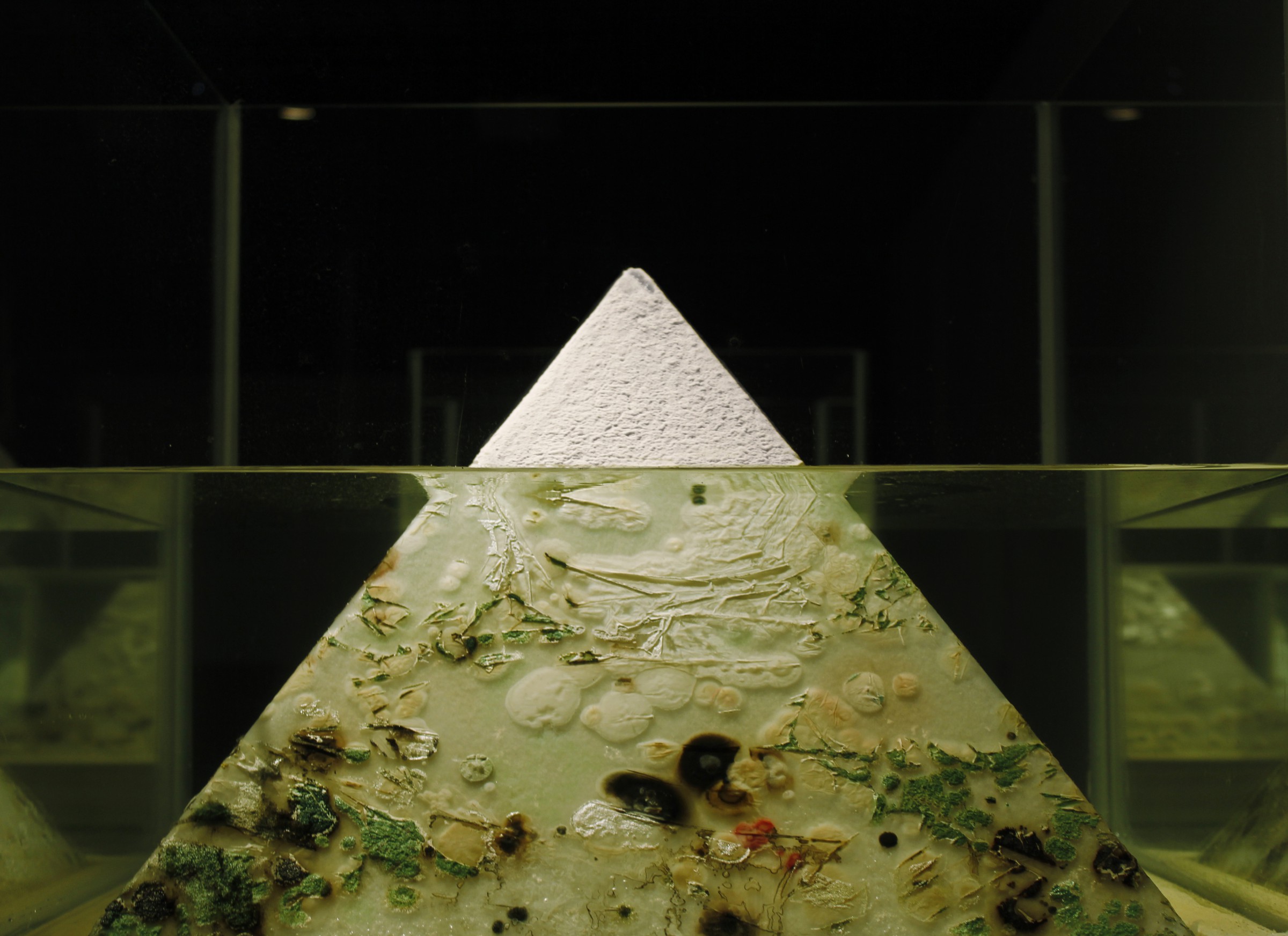 |
|
“Water Level”
Site-specfic live art | Water, microorganisms, nutients | 60 x 60 x 60 cm | 2009
|
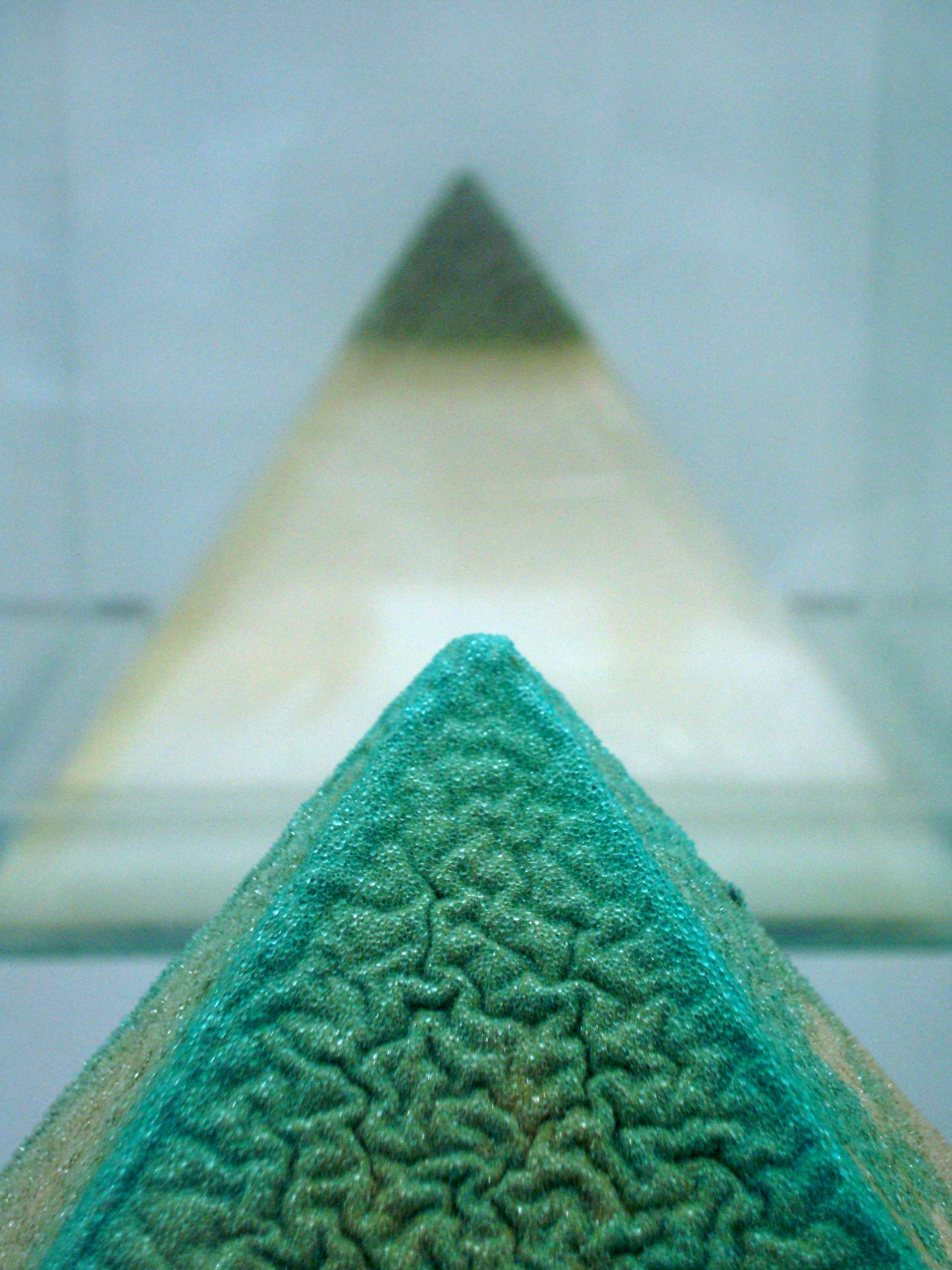 |
|
“Water Level”
Site-specfic live art | Water, microorganisms, nutients | 60 x 60 x 60 cm | 2009
|
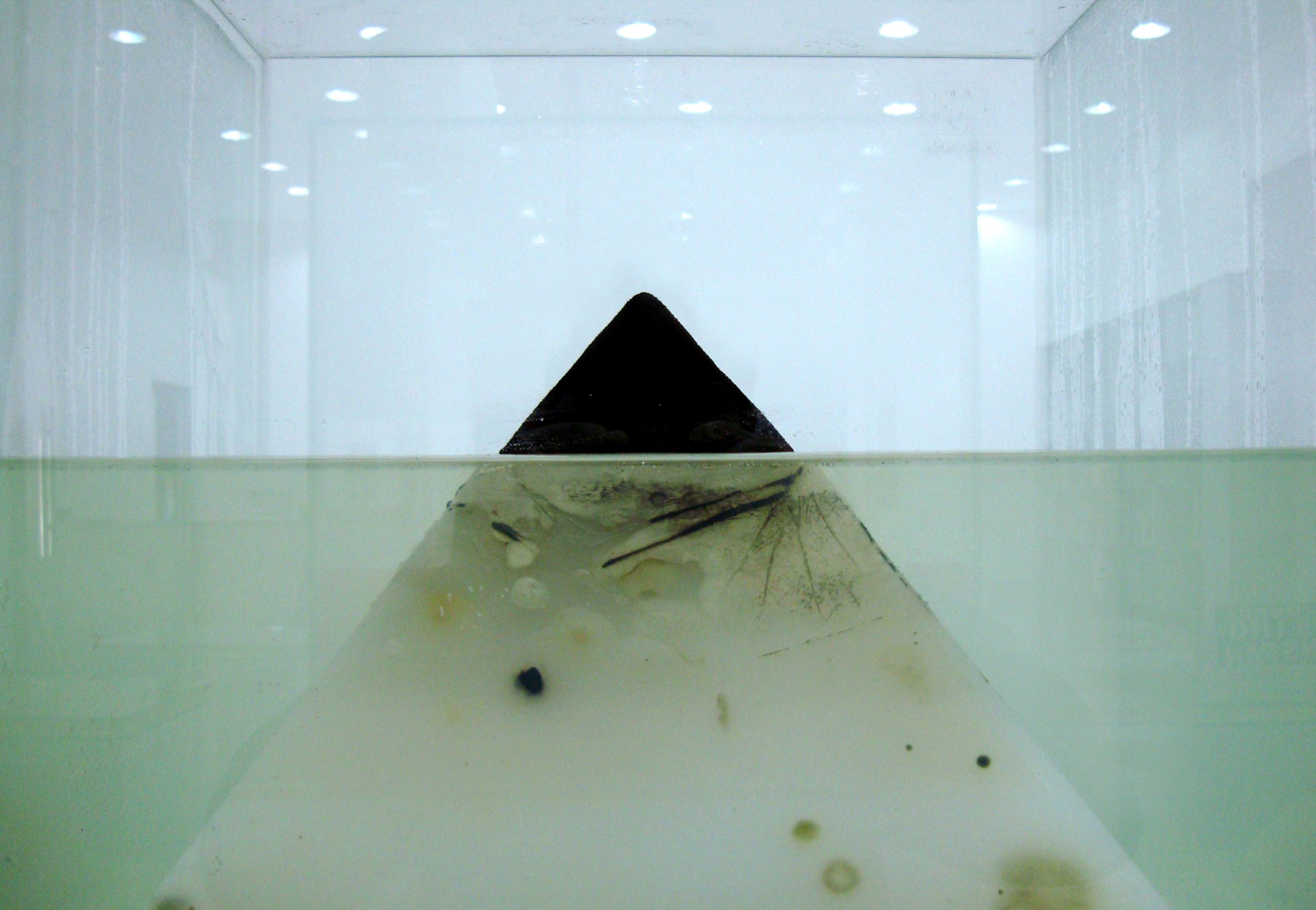 |
|
“Water Level”
Site-specfic live art | Water, microorganisms, nutients | 60 x 60 x 60 cm | 2009
|
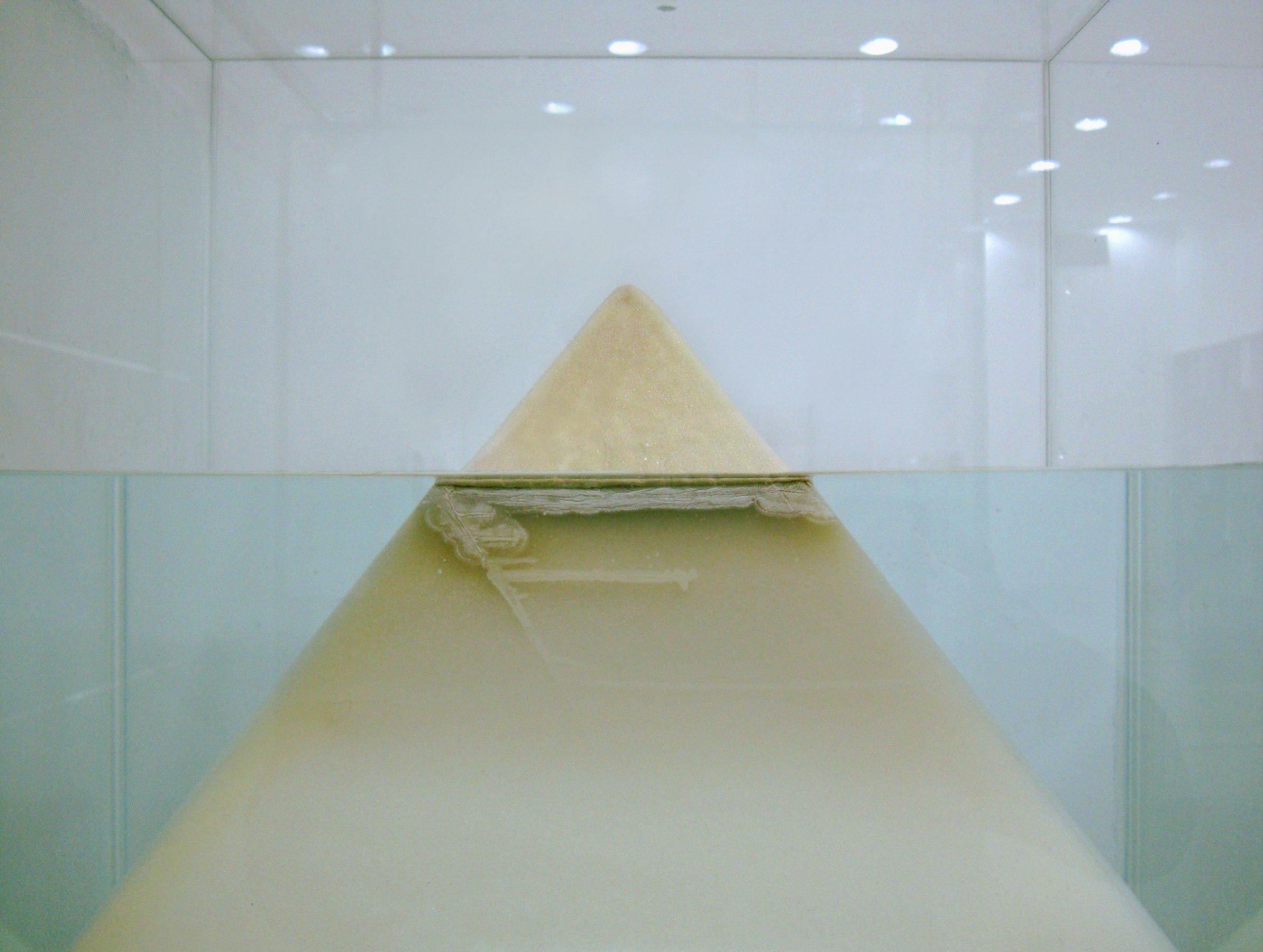 |
|
“Water Level”
Site-specific live art | Water, microorganisms, nutients | 60 x 60 x 60 cm | 2009
|
The creation process of the installation “Water Level” is as follows: Fill the glass box with water, control the water level in the middle of the glass box, and then put the quadrangular pyramidal microbiological nutrient body into the water. The upper part of the nutrient body (the part above the initial water level) is artificially inoculated, and a single strain grows. The microorganisms in the air cannot grow above the water surface. The lower part of the nutrient body (the part below the initial water level) is not artificially inoculated, and microorganisms in the water can grow naturally on it. As the water vapor evaporates and the water level drops, the lower part of the nutrient body begins to react with microorganisms in the air and the upper part of the microorganisms, blurring the dividing line of the nutrient body until all the water evaporates.
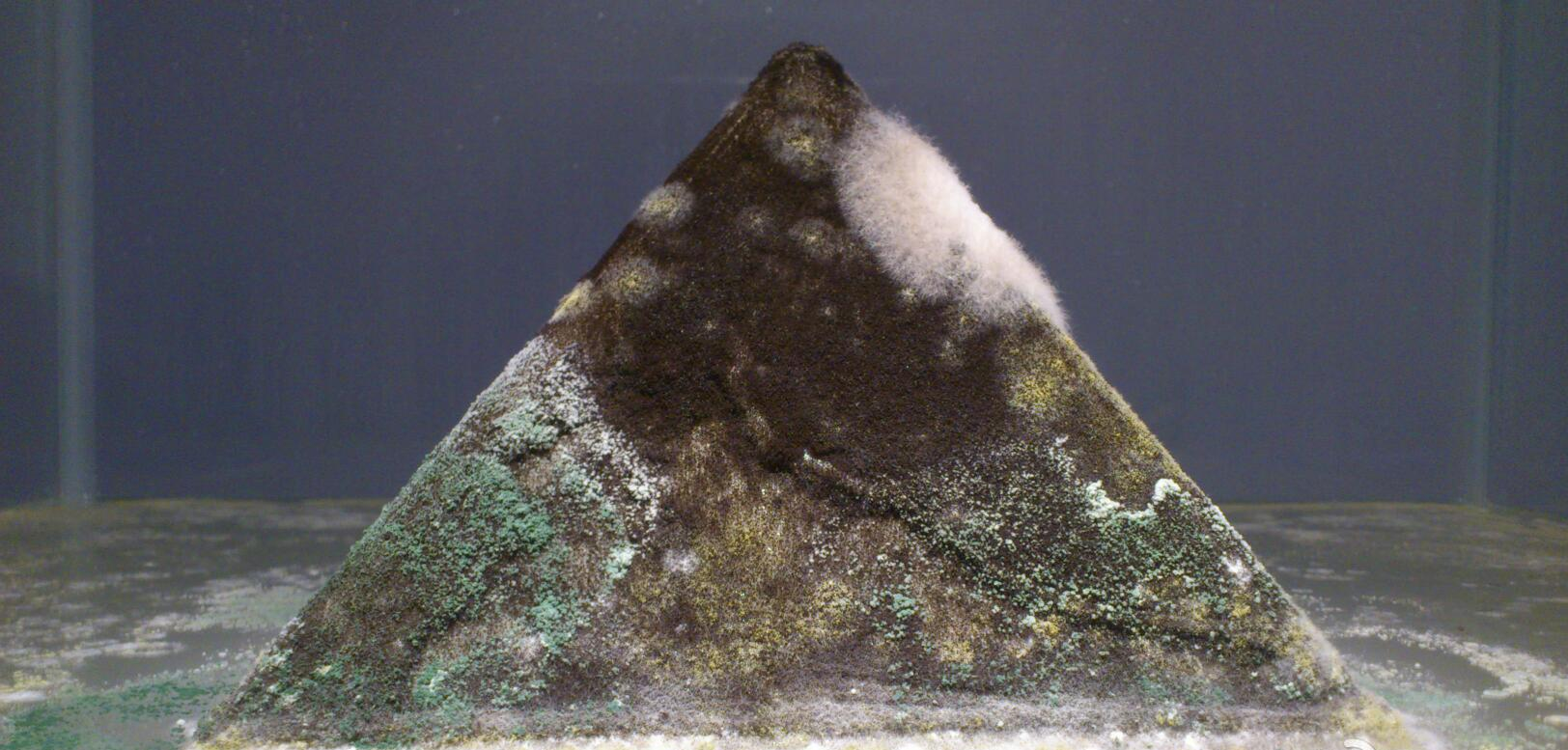 |
|
"Water Level"
Site-specfic live art | Water, microorganisms, nutients | 60 x 60 x 60 cm | 2012
|
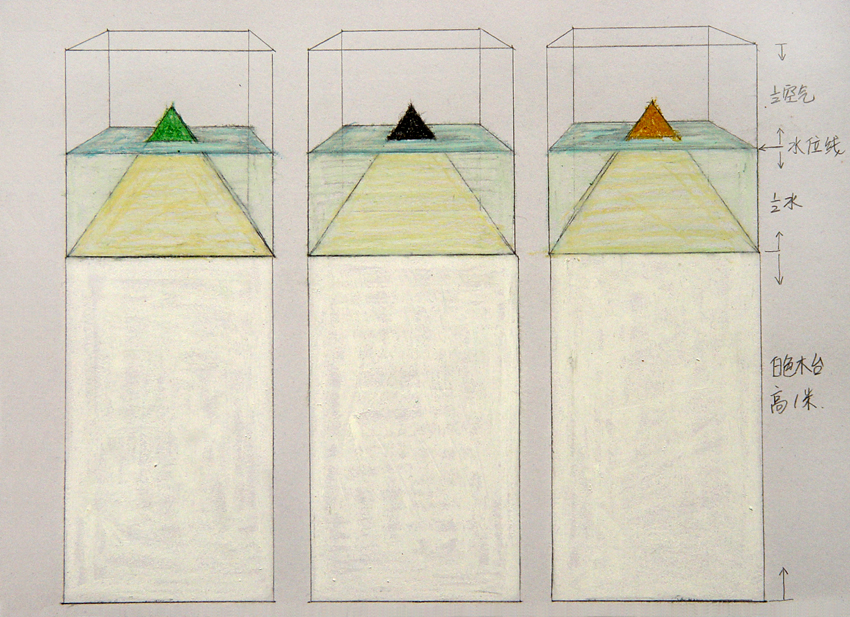 |
|
“Water Level” (a planning graph)
|
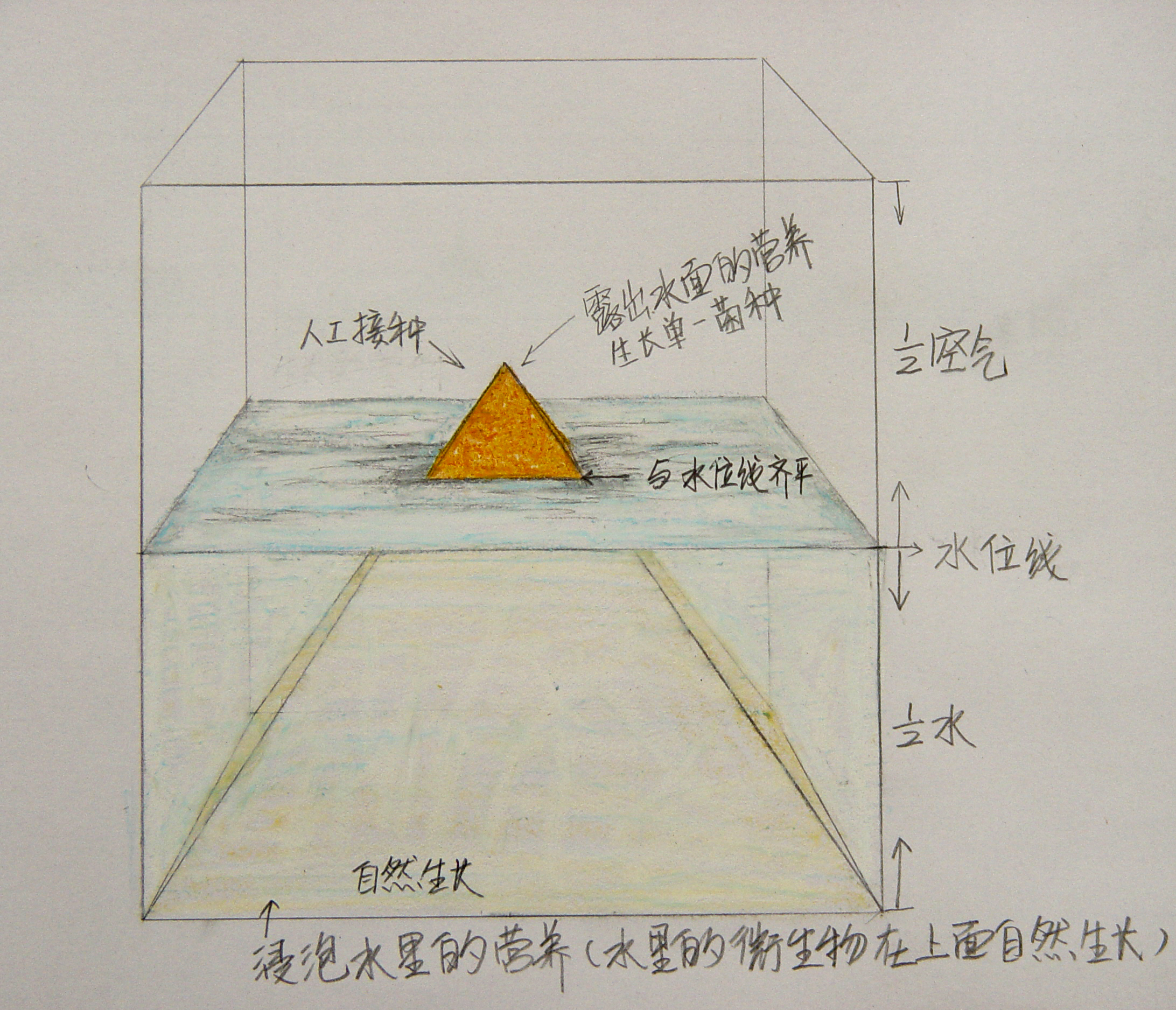 |
|
“Water Level” (a planning graph)
|
Dead trees will return to nature through the decomposition of microorganisms. Green Trichoderma is one of the microorganisms that love to eat dead trees. It secretes green pigment when it decomposes trees. In the exhibition hall, the artist inserted the collected dead tree branches in the soil and then painted the green Trichoderma on the branches. In order to ensure humidity to facilitate the reproduction of microorganisms, the artist covered a layer of plastic film on the tree branches. The color of the colony was white at first, but as time passed, the tree branches gradually turned green, and on the third day they were completely covered with green as if they had come back to life.
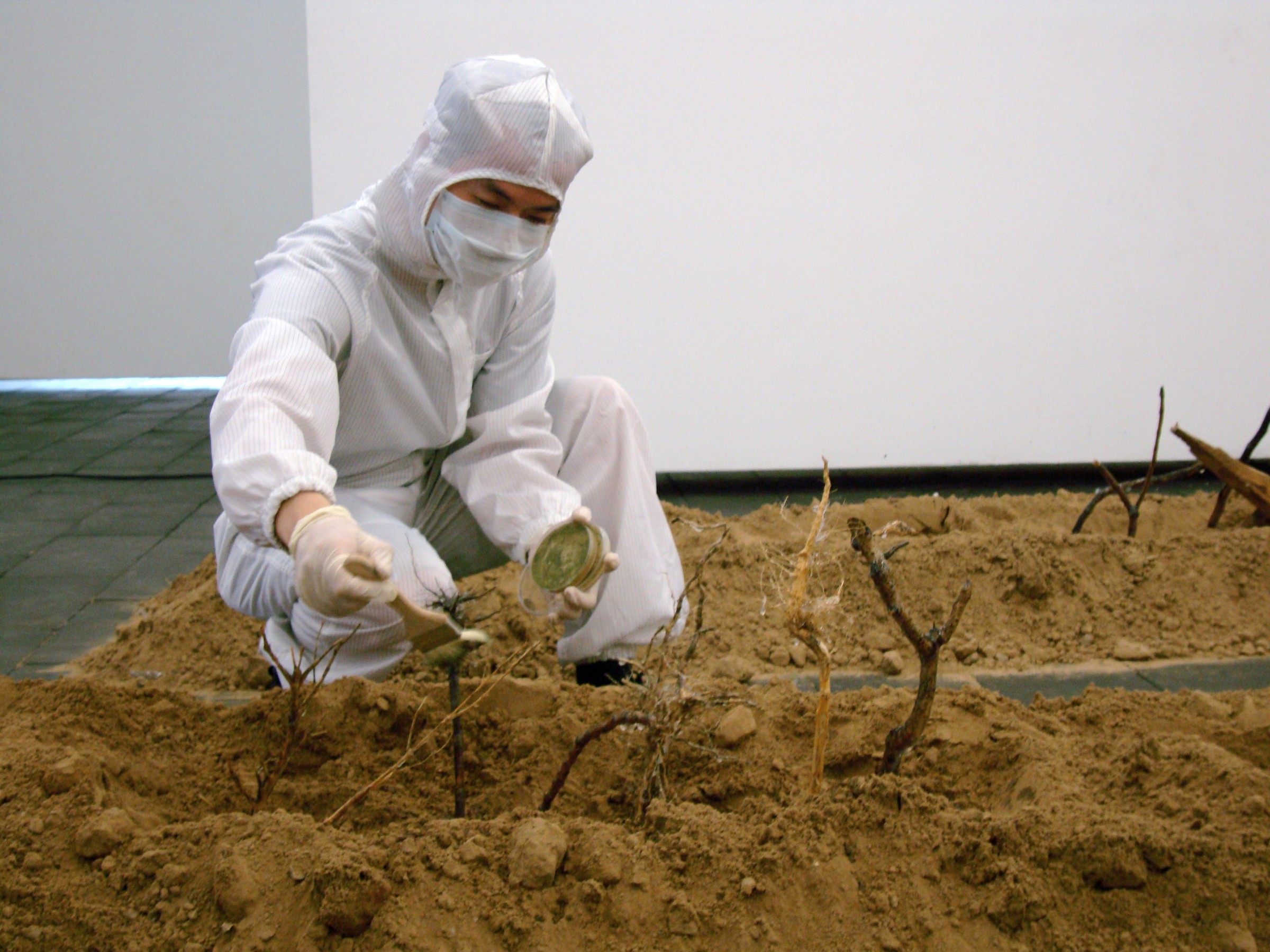 |
|
"Plant"
Site-specific live art | microorganisms, soil, dead tree branches, plastic film | 2010
|
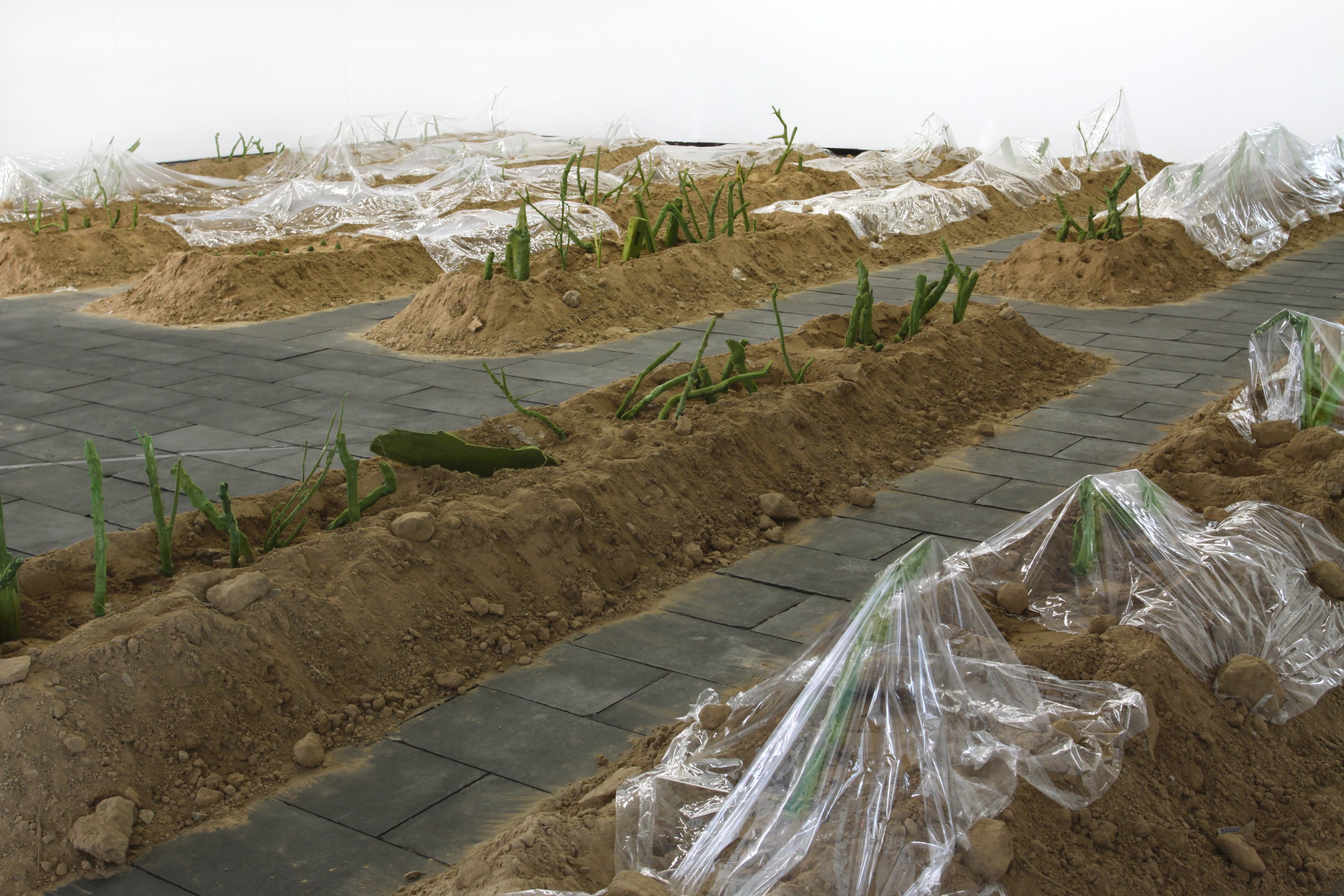 |
|
"Plant"
Site-specific live art | microorganisms, soil, dead tree branches, plastic film | 2010
|
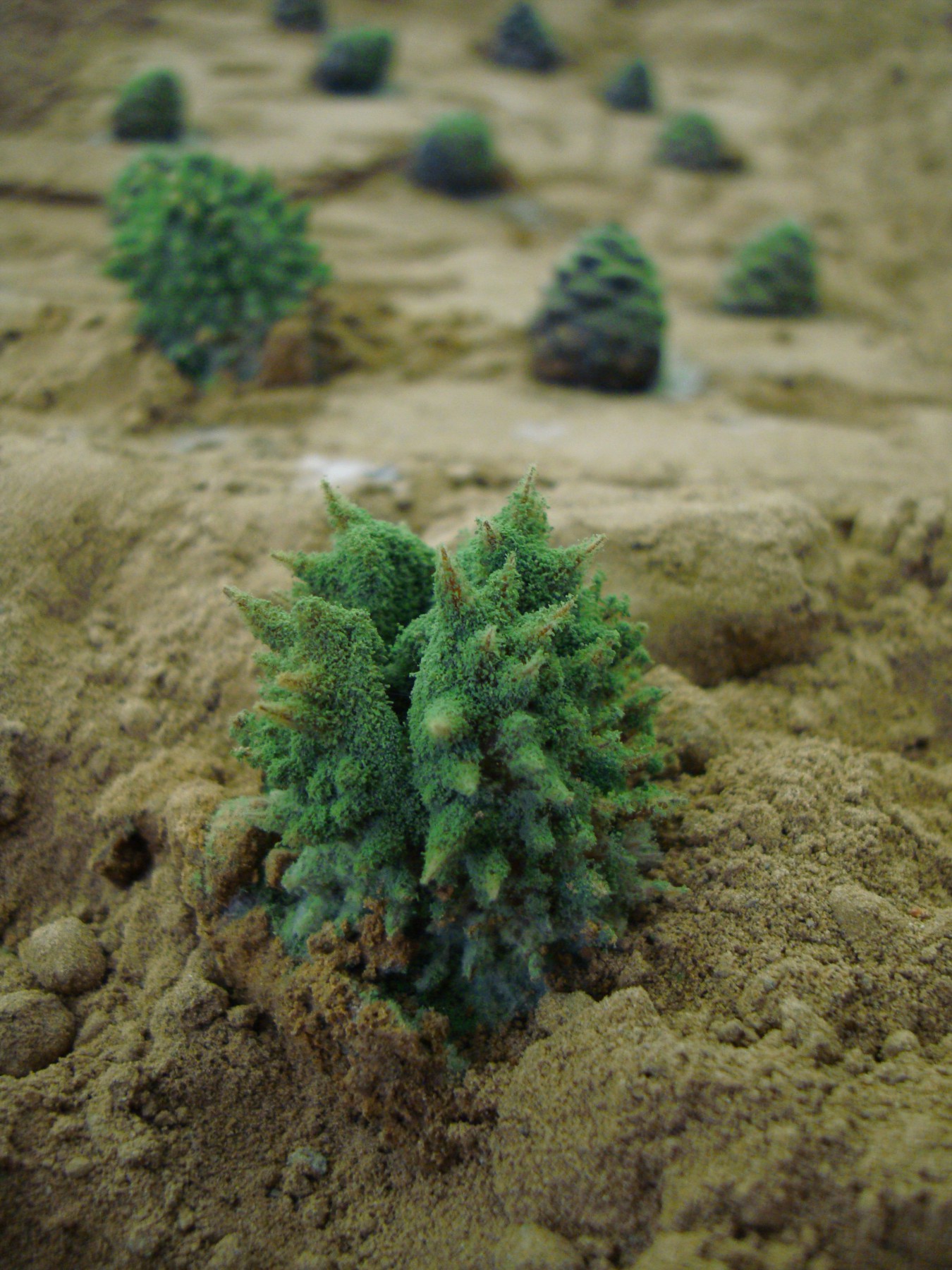 |
|
"Plant"
Site-specific live art | microorganisms, soil, dead tree branches, plastic film | 2010
|
The artist smashed plants, meat, soil, stones, and other substances separately, transferred them into the configured antibacterial potion, condensed them into small piles, and placed them together with the microorganisms on the platform. Under the action of the antibacterial potion, a transparent antibacterial zone is formed on the platform. The blank areas of different substances merge with each other, revealing the yardage of the ruler below, showing the real-time distance between various substances and microorganisms. The antibacterial properties of various organisms and inorganic bodies and the drug resistance of microorganisms determine the size, existence, and disappearance of distances, and they are in constant movement and change.
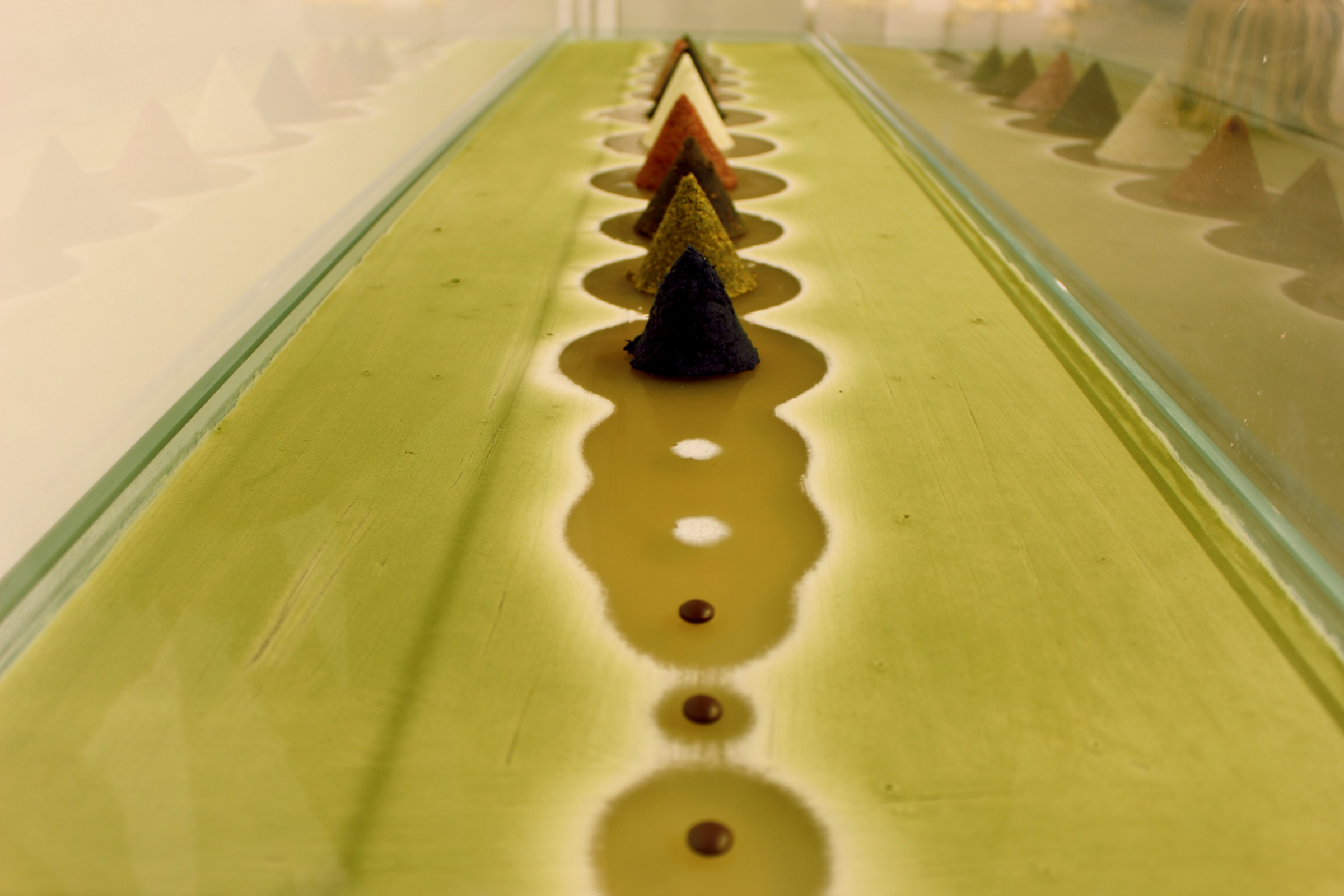 |
|
"Distance"
Site-specific live art | Microorganisms, antimicrobial drugs, vegetable, meat, etc. | 40 x 200 cm | 2012
|
 |
|
"Distance"
Site-specific live art | Microorganisms, antimicrobial drugs, vegetable, meat, etc. | 40 x 200 cm | 2012
|
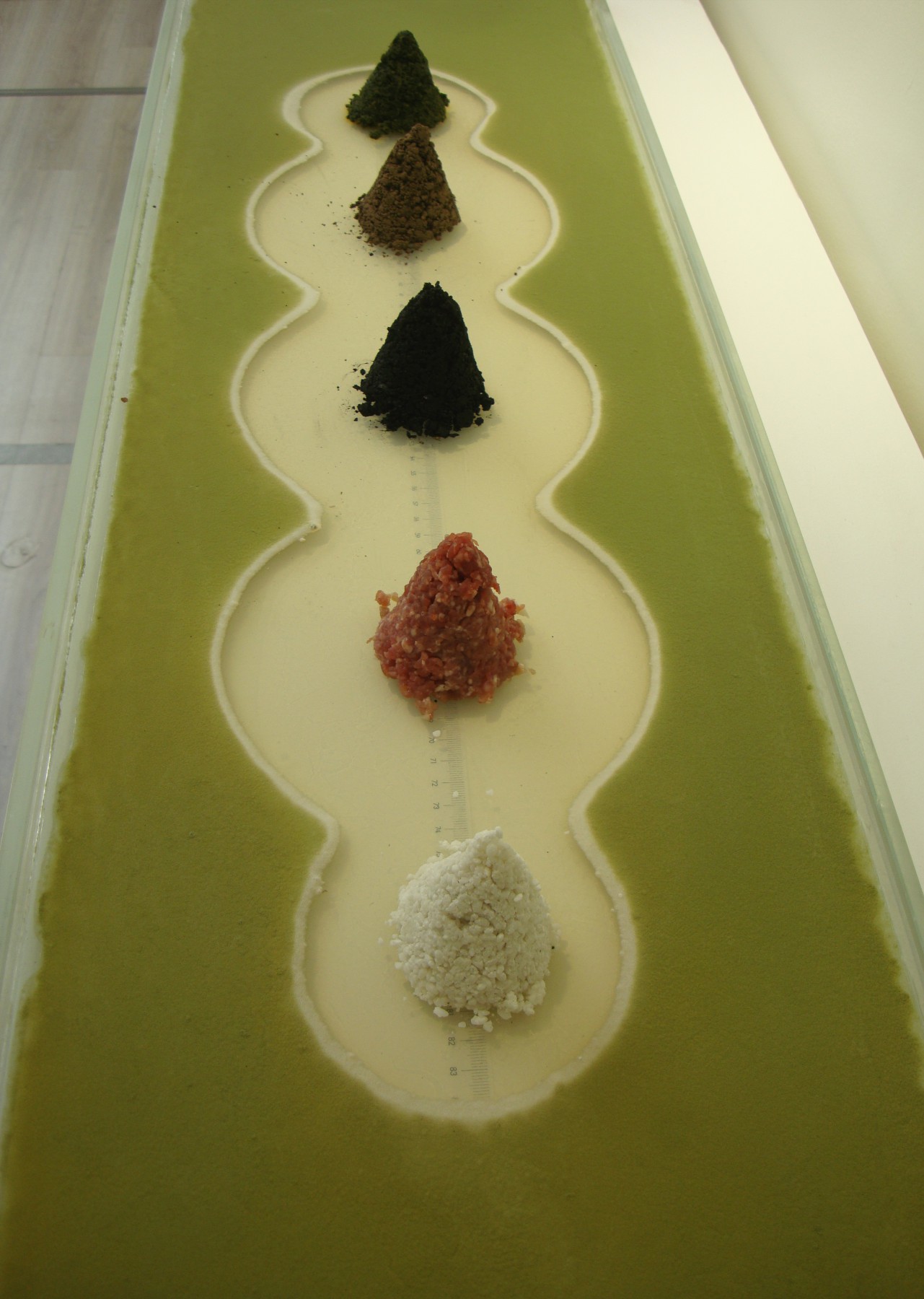 |
|
“Distance”
Site-specific live art | Microorganisms, antimicrobial drugs, Ruler, biological utensils, plants, meat, etc. | 40 x 200 cm | 2011
|
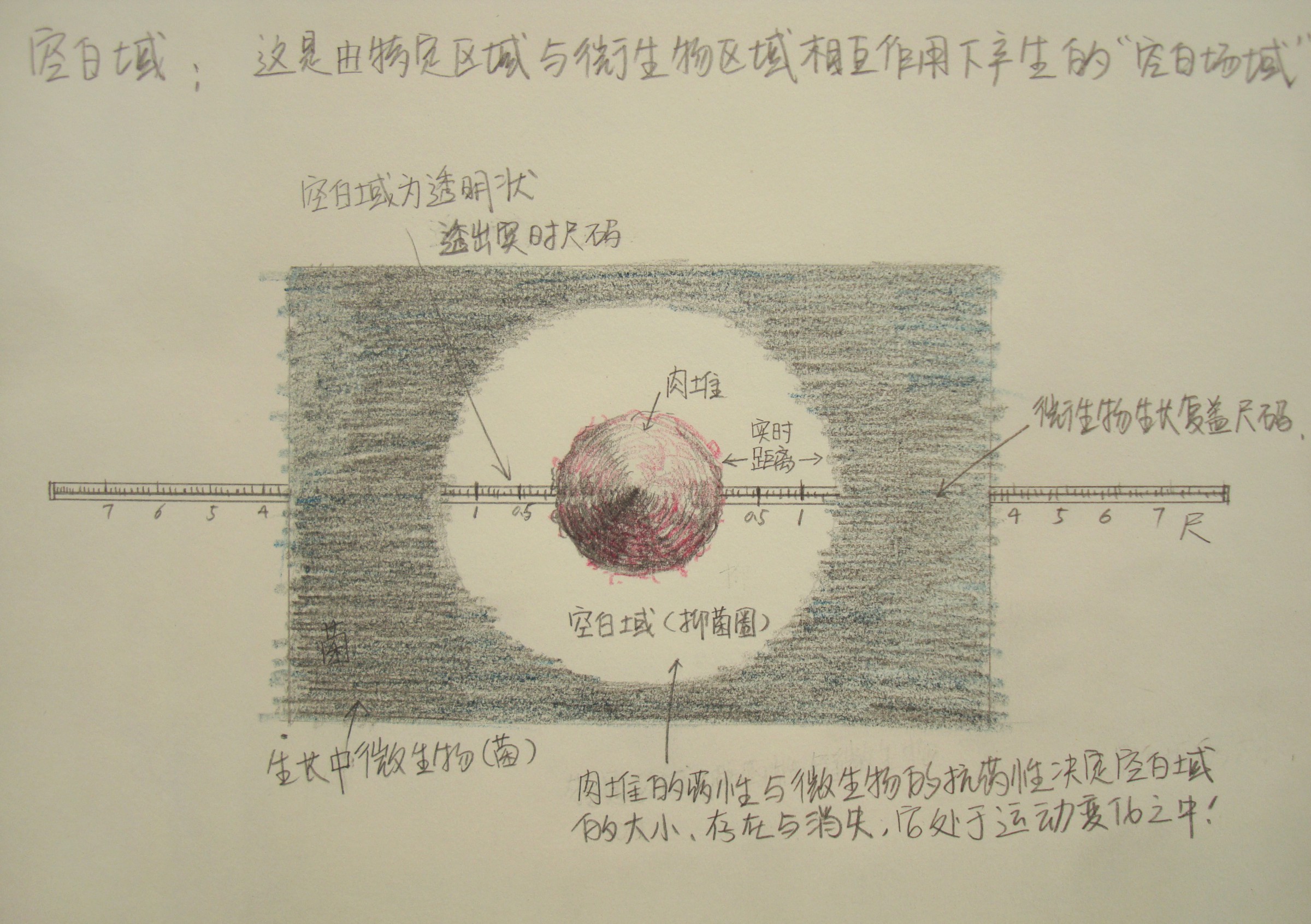 |
|
“Distance” (a sketch)
|
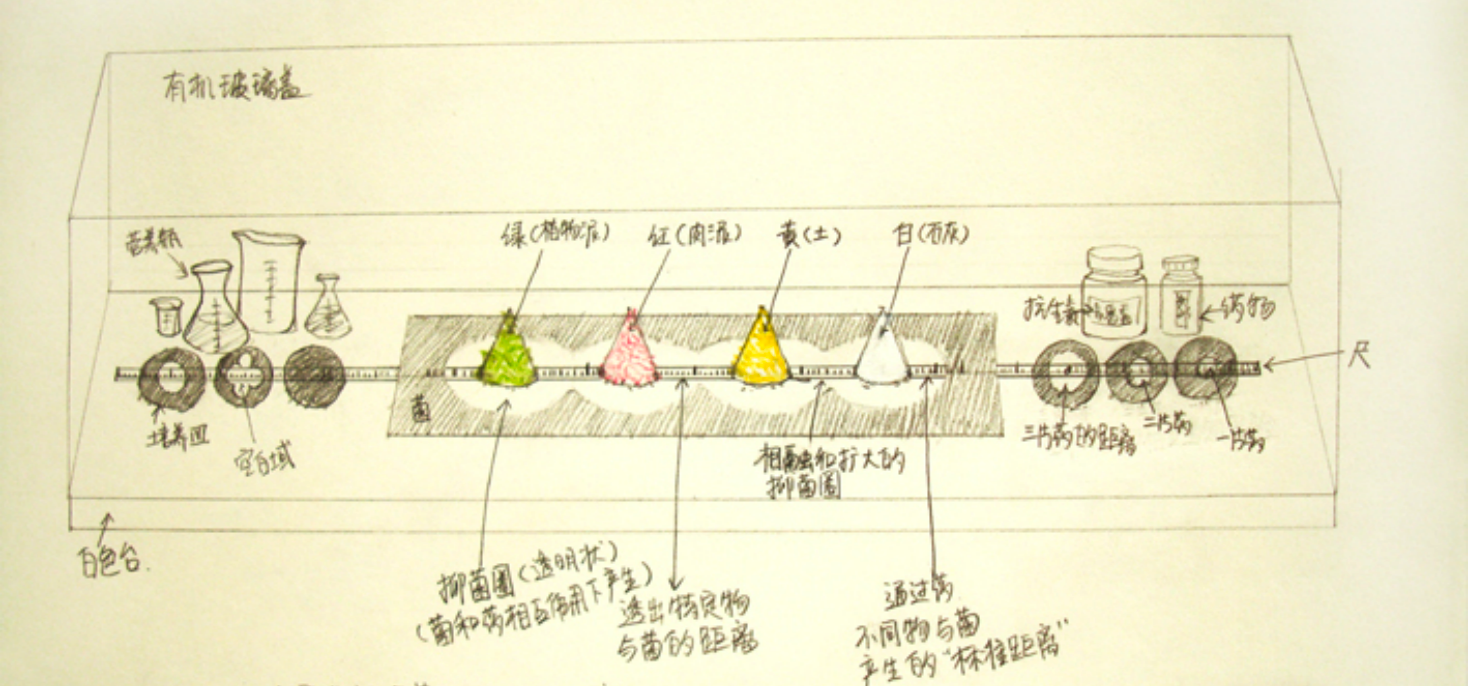 |
|
“Distance” (a sketch)
|
"Ink of the Process" uses Aspergillus carbonarius. The artist first smashed different objects to form different nutrient cones, then brushed them with Aspergillus carbonarius and placed them on paper. Aspergillus charcoal was white when it first grew on the nutrient cones and slowly turned black. Due to the different materials of each cone, the speed and effect of microbiological diffusion and growth were different, leaving different "traces of ink" on the paper.
 |
|
Different items are crushed and processed to form a nutrient cone.
|
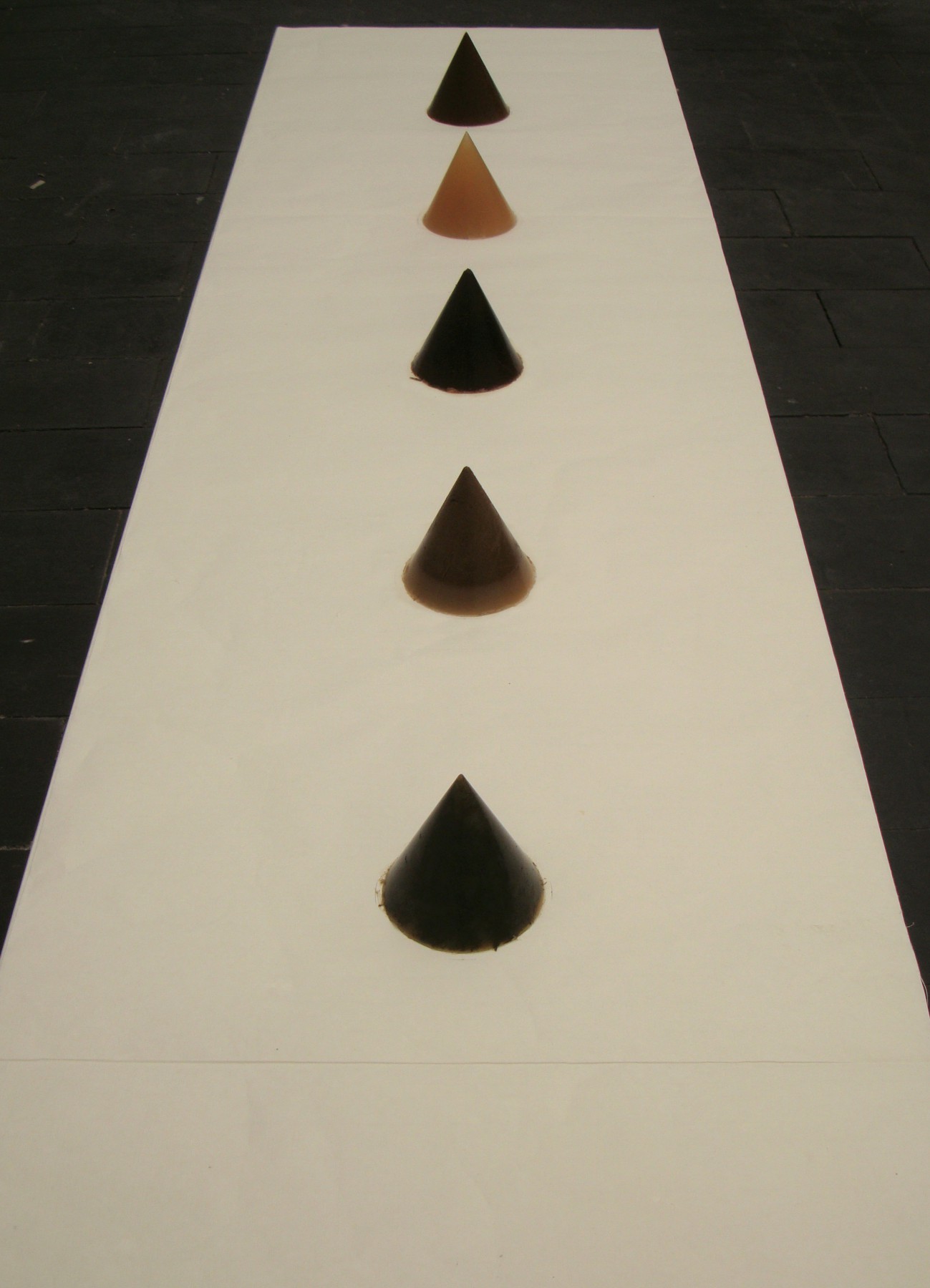 |
|
"Ink of the Process" (Day 1)
Site-specific live art | Molds that can secrete carbon melanin, nutrient bodies made by crushing various items, white paper | 2012
|
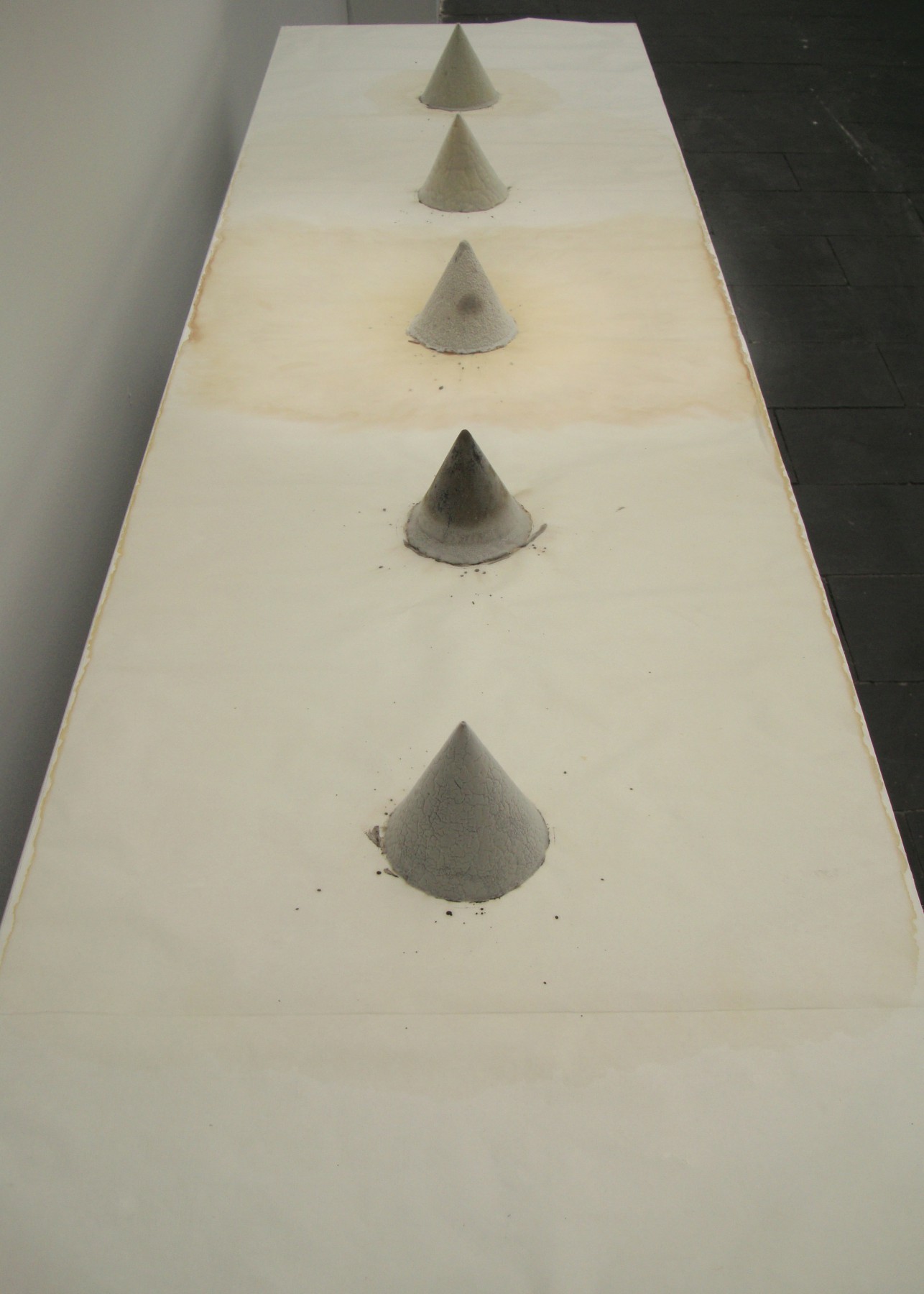 |
|
"Ink of the Process" (Day 2)
Site-specific live art | Molds that can secrete carbon melanin, nutrient bodies made by crushing various items, white paper | 2012
|
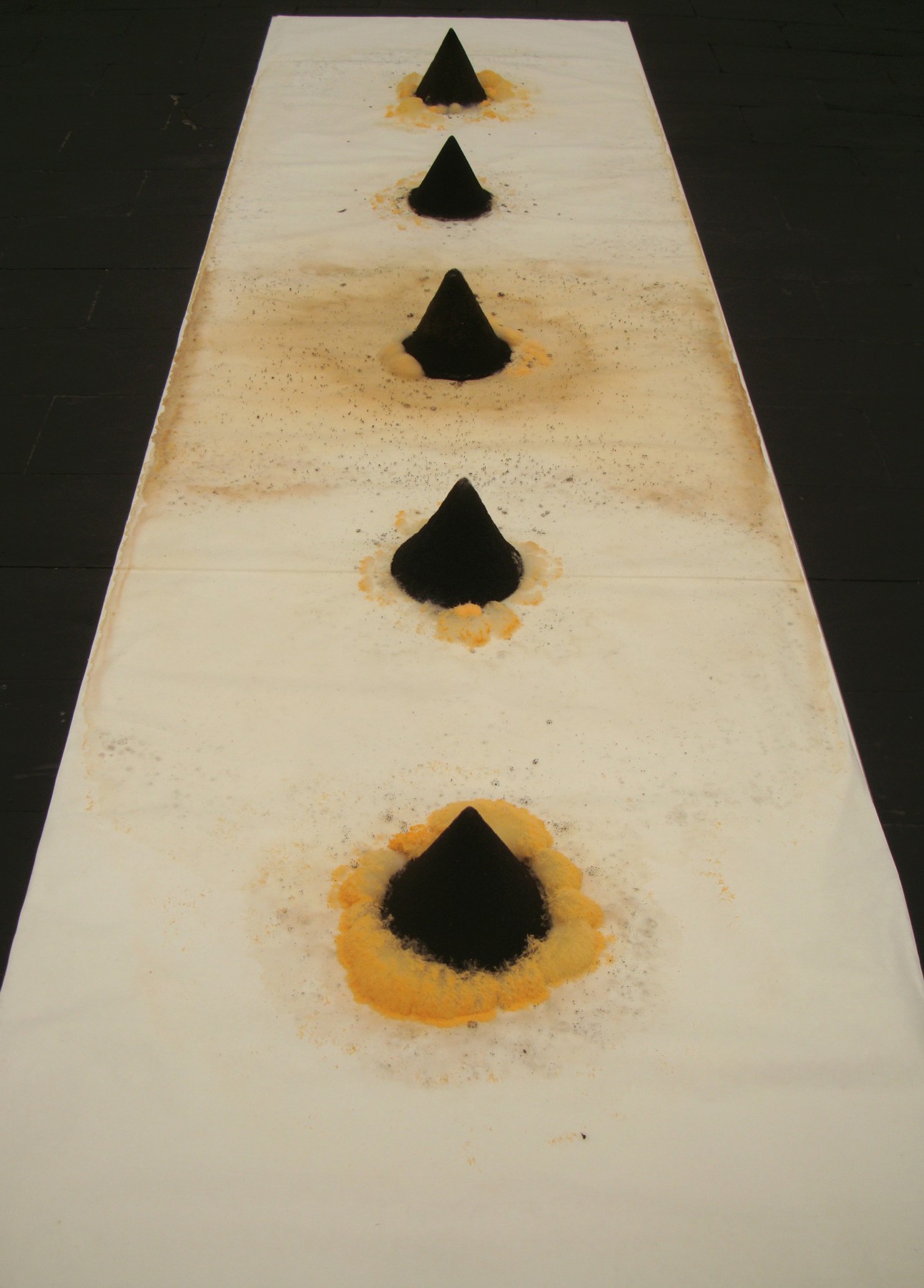 |
|
"Ink of the Process" (Day 3)
Site-specific live art | Molds that can secrete carbon melanin, nutrient bodies made by crushing various items, white paper | 2012
|
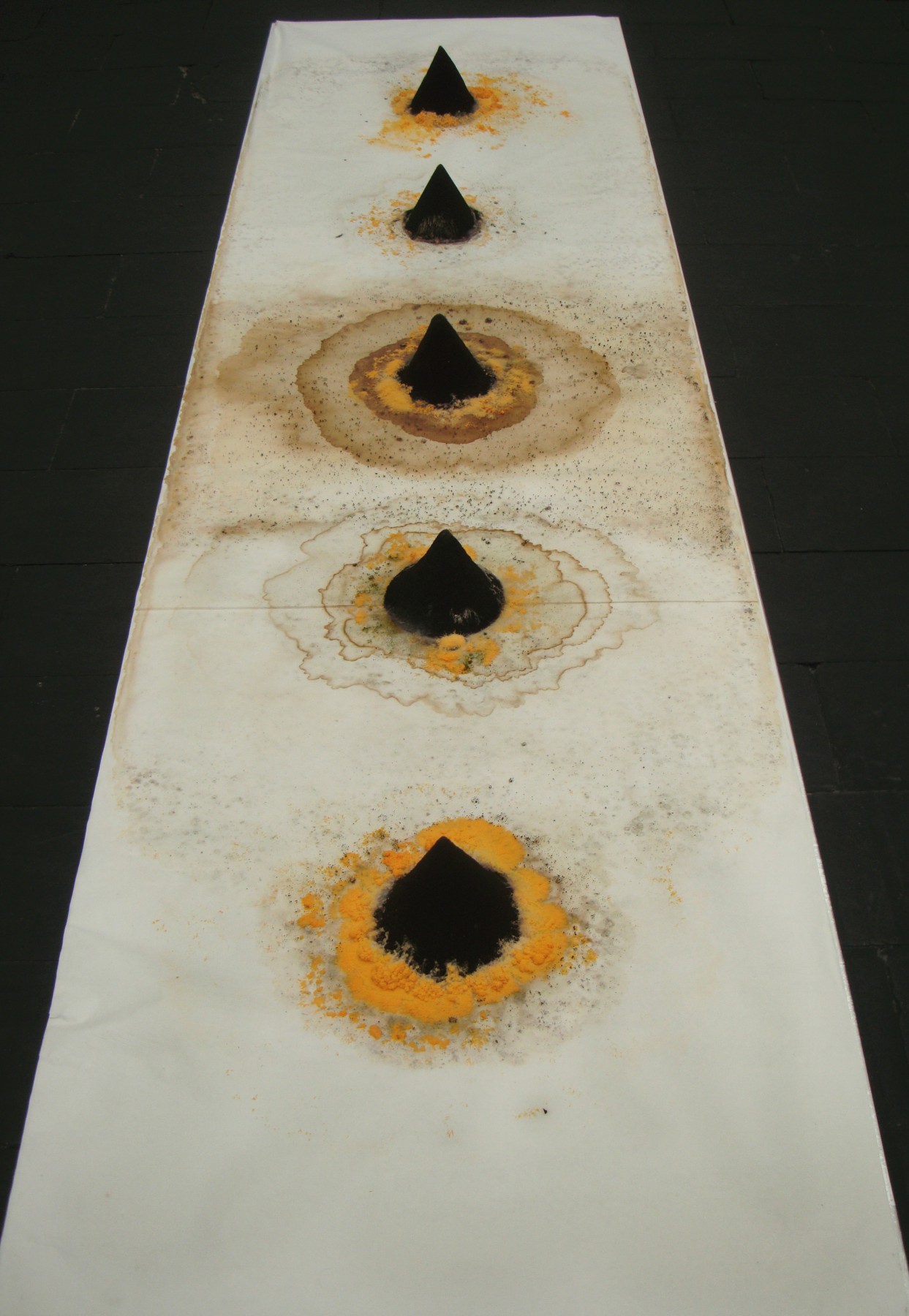 |
|
"Ink of the Process" (Day 5)
Site-specific live art | Molds that can secrete carbon melanin, nutrient bodies made by crushing various items, white paper | 2012
|
The form of "Circle" is simple, using a common shape of microbiological life——a circle, to show the characteristics of individual microorganisms and the mutual resistance and symbiotic relationship between individuals.
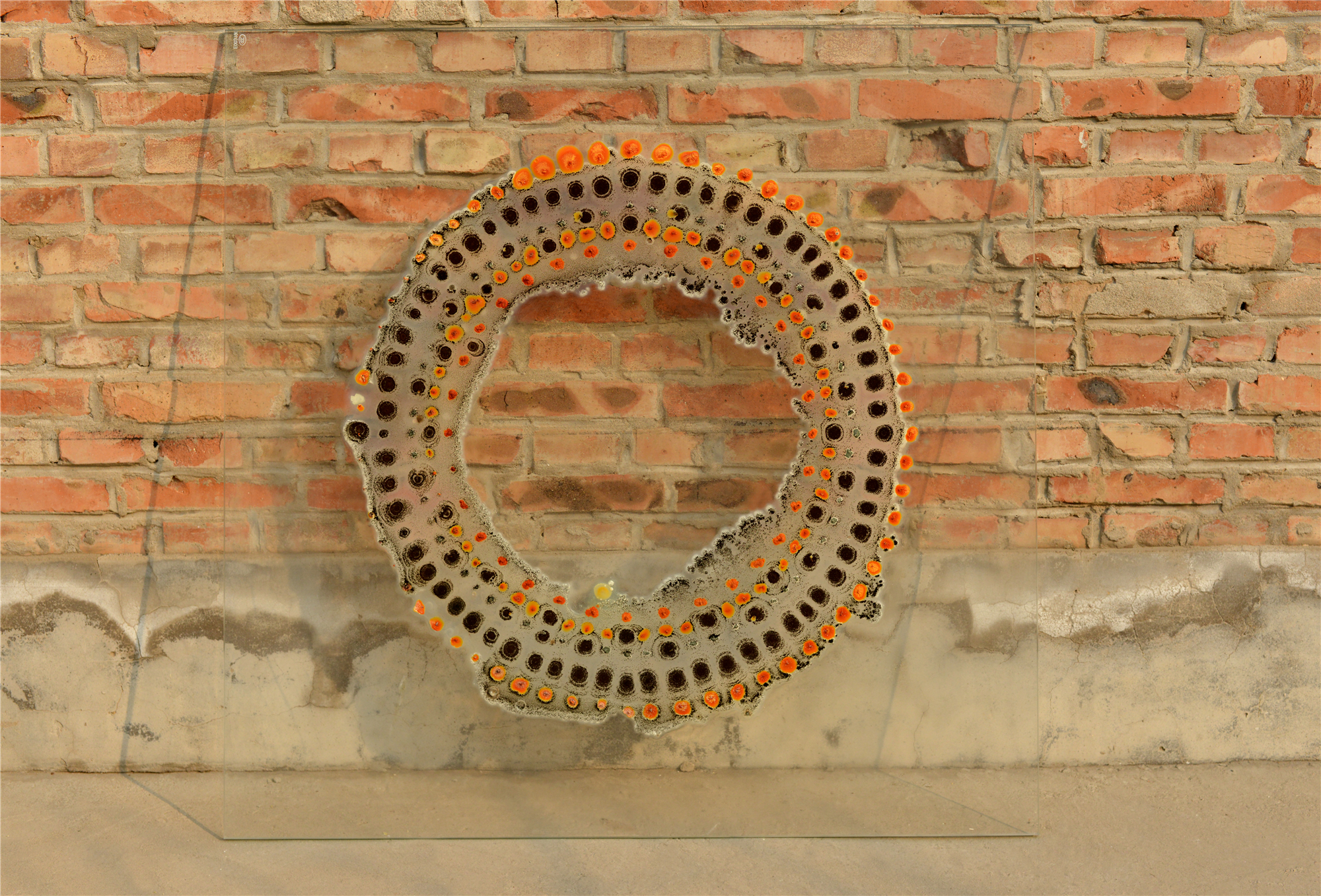 |
|
“Circle”
Aspergillus charcoal, Aspergillus orange, Monascus, antibiotics, nutrient bodies, glass | 100 x 100 cm | 2015
|
 |
|
“Circle”(Detailed view)
Aspergillus charcoal, Aspergillus orange, Monascus, antibiotics, nutrient bodies, glass | 100 x 100 cm | 2015
|
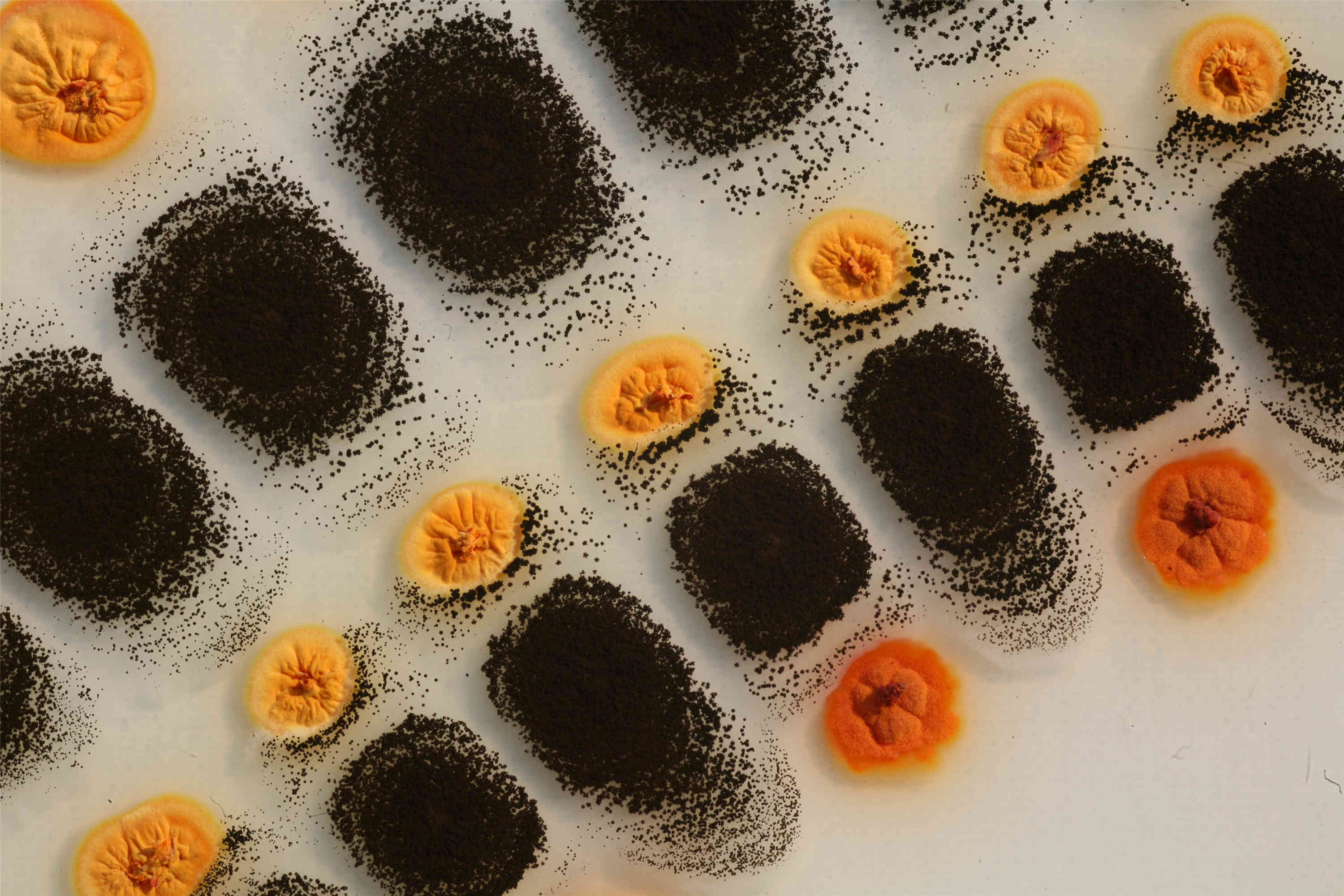 |
|
“Circle”(Detailed view)
Aspergillus charcoal, Aspergillus orange, Monascus, antibiotics, nutrient bodies, glass | 100 x 100 cm | 2015
|
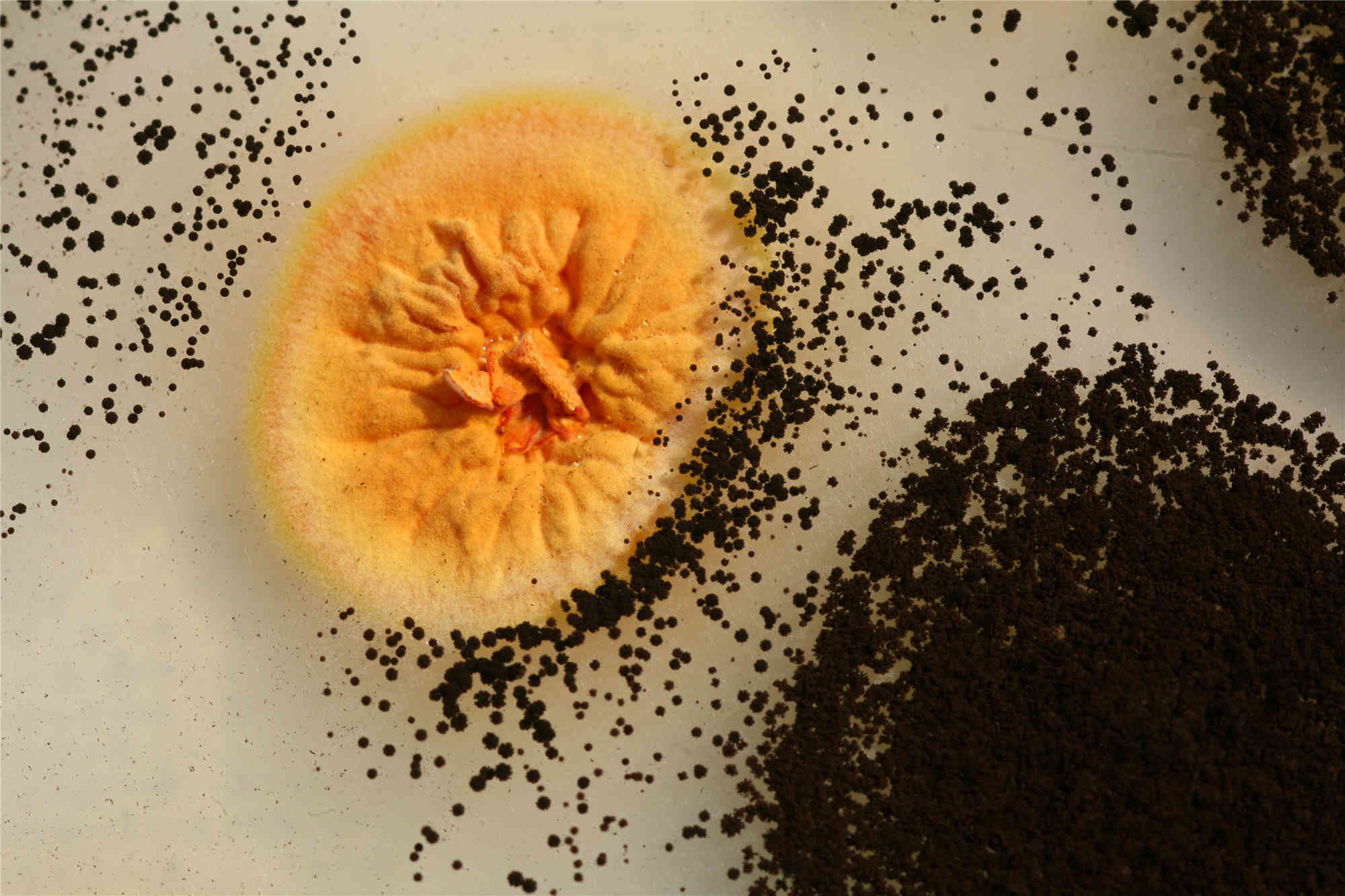 |
|
“Circle”(Detailed view)
Aspergillus charcoal, Aspergillus orange, Monascus, antibiotics, nutrient bodies, glass | 100 x 100 cm | 2015
Inhibitory effect of Aspergillus charcoal on Aspergillus orange
|
The entire black in the work comes from black bacteria, and the red line is on the surface of the same nutrient body together with it. The two red threads in the middle carry charcoal bacteria, which are blacker than black bacteria, and are constantly eroded by it. Charcoal bacteria and black bacteria contain each other and naturally produce regular boundaries. At the same time, charcoal bacteria spread to the black bacteria while eroding the red threads.
The red threads on both sides carry the antibiotics, and their color remains bright, splitting an irregular blank area with the black bacteria. The shape and size of the blank area are determined by the efficacy of the antibiotics and the resistance of the black bacteria, and they are in a state of movement. It took two days for the microorganisms to grow in the nutrient solution to the shape shown in the figures below.
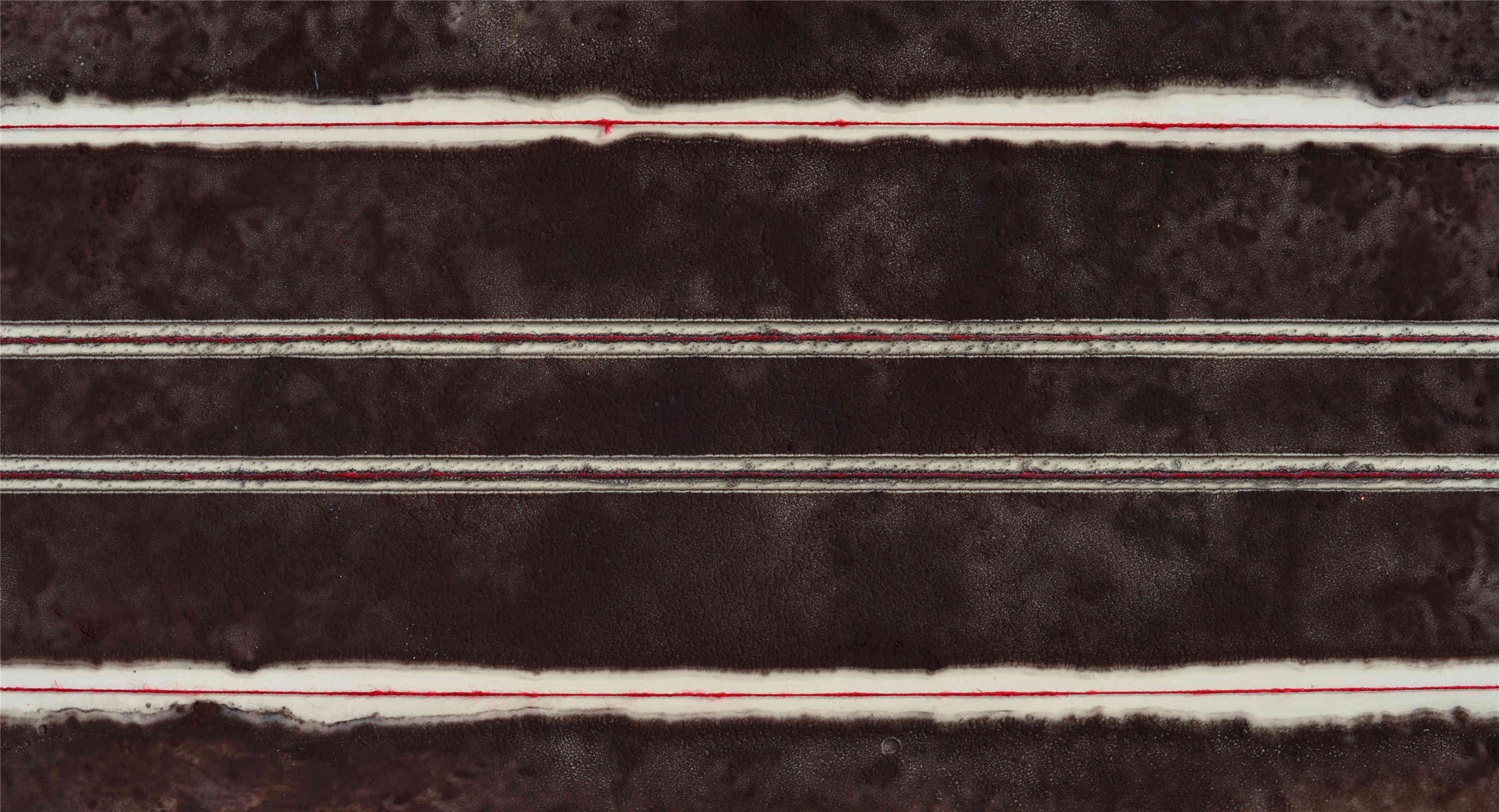 |
|
“Organization”
Site-specific live art| Black bacteria, charcoal black bacteria, antibiotics, red threads, nutrient bodies | 150 x 50 cm | 2015
|
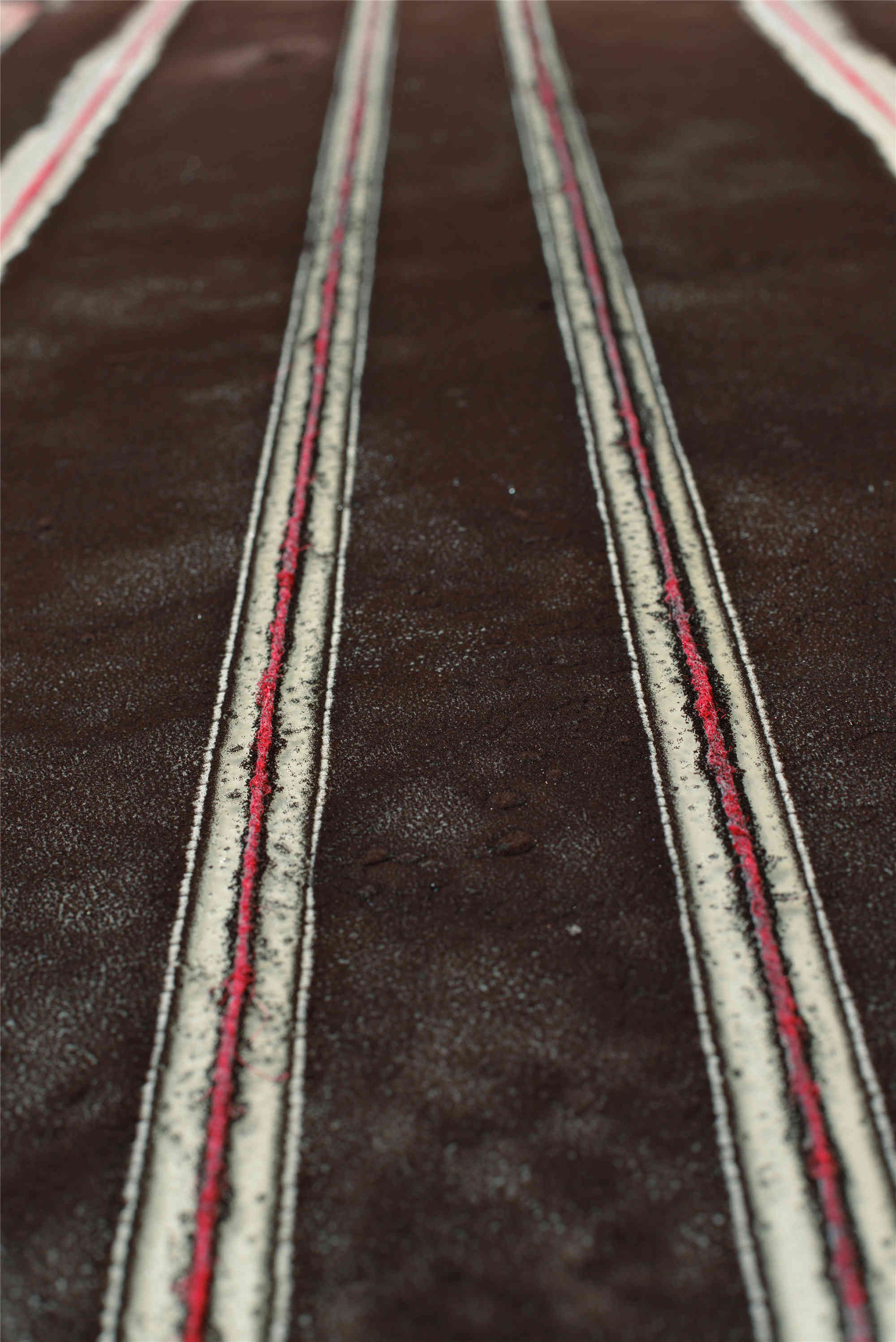 |
|
“Organization”
Site-specific live art| Black bacteria, charcoal black bacteria, antibiotics, red threads, nutrient bodies | 150 x 50 cm | 2015
|
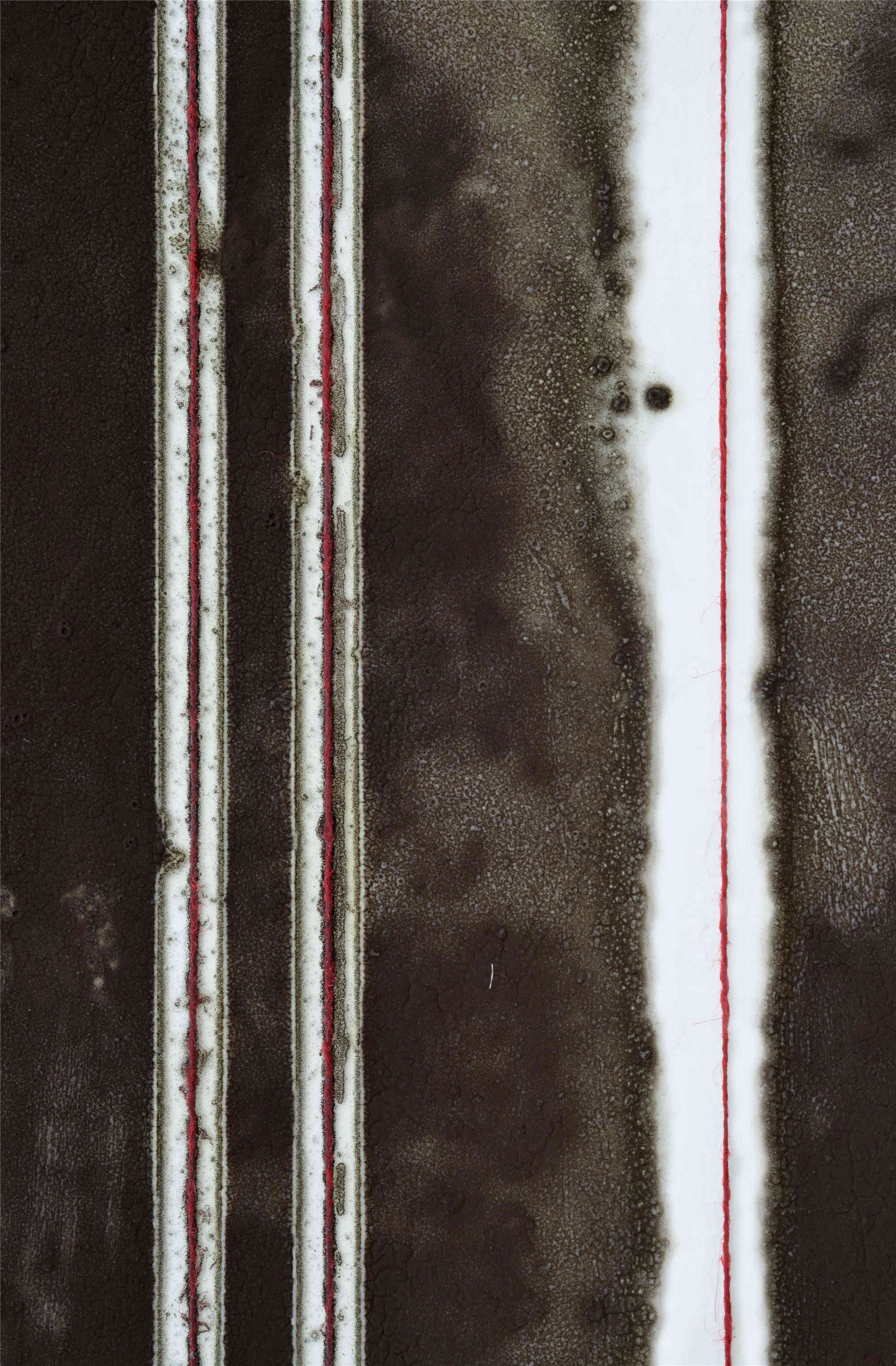 |
|
“Organization”
Site-specific live art| Black bacteria, charcoal black bacteria, antibiotics, red threads, nutrient bodies | 150 x 50 cm | 2015
|
 |
|
“Organization”
Site-specific live art| Black bacteria, charcoal black bacteria, antibiotics, red threads, nutrient bodies | 150 x 50 cm | 2015
|
The black bacteria and the red threads are on the same nutrient body. The red threads are soaked with charcoal bacteria and are constantly eroded by it. The charcoal bacteria and the black bacteria inhibit each other to form a regular blank space. At the same time, antibiotics are injected into the nutrient bodies through 8 needles, forming a circular blank area, forming a relatively balanced state with the black bacteria. The red threads in the round blank area are protected from the erosion of charcoal bacteria.
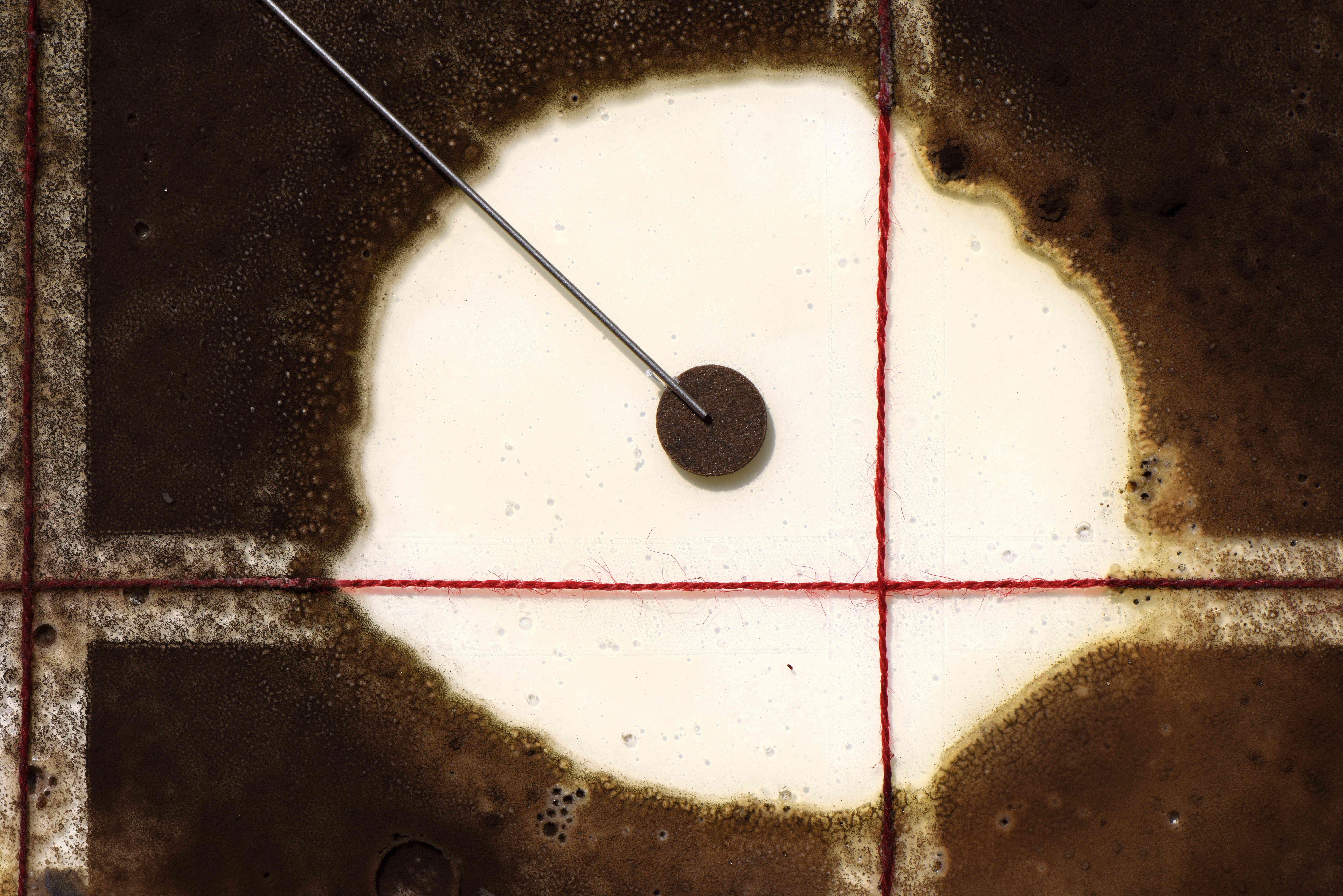 |
|
“Sensitive”(Detailed view)
Site-specific live art| Black bacteria, charcoal bacteria, red threads, antibiotics, stainless steel needles, nutrient bodies | 100 x 100 cm | 2015
|
 |
|
“Sensitive”(Detailed view)
Site-specific live art| Black bacteria, charcoal bacteria, red threads, antibiotics, stainless steel needles, nutrient bodies | 100 x 100 cm | 2015
|
|
"Sensitive" (a video with exhibits)
Video | Charcoal bacteria, antibiotics, potatoes, nutrient bodies | 27″ | 2015
|
(The text is based on the dialogue between the project team and Chen Youtong. All pictures and videos are provided by the artist. All rights reserved.)

